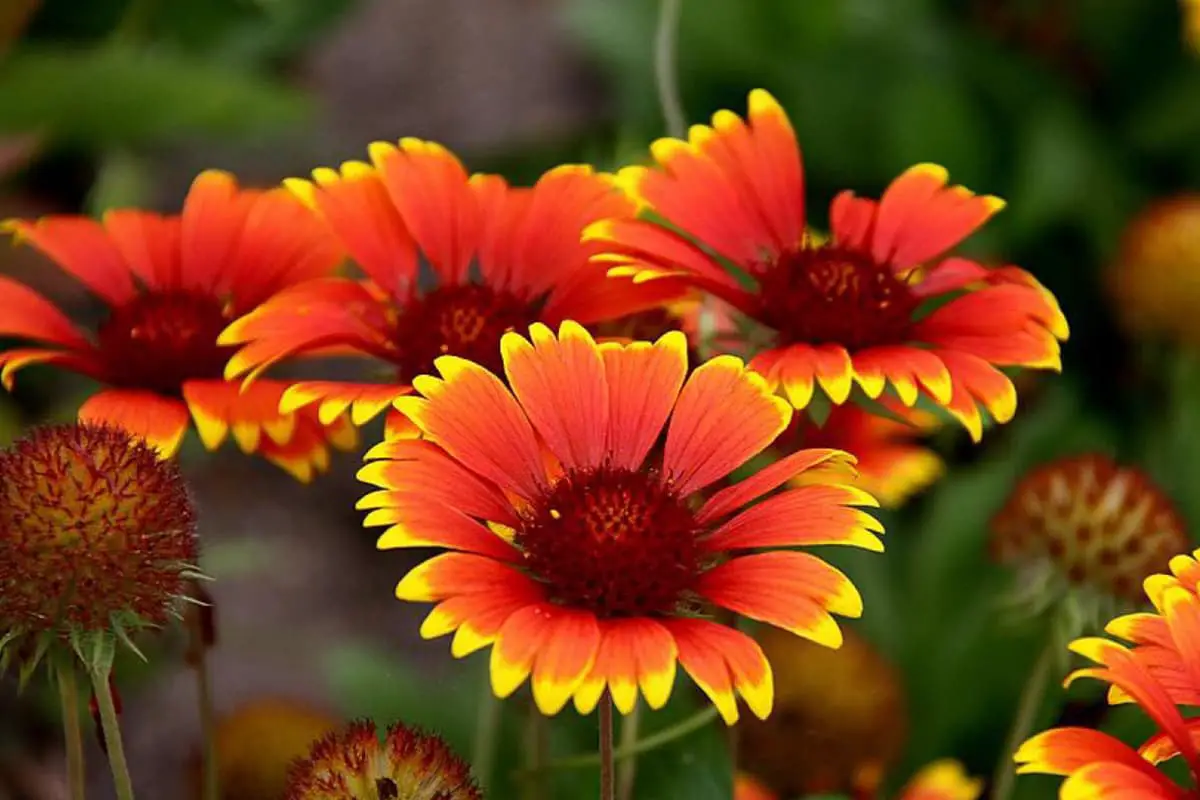
Gaillardia pulchella (Indian Blanketflower): Gaillardia pulchella, a vibrant member of the Asteraceae family and Gaillardia genus, is an annual herbaceous plant that typically grows 20-60 cm (8-24 inches) tall. This robust plant features multiple branches adorned with soft, downy hairs, giving it a slightly fuzzy appearance.
The leaves are arranged alternately along the stems and exhibit considerable variation in shape, ranging from elliptic to lanceolate or spatulate. They may be entire or display pinnately lobed bases, adding to the plant’s textural interest. The foliage is often a medium to dark green, providing an excellent backdrop for the showy flowers.
The inflorescences are striking, solitary flower heads borne at the ends of long stems. Each flower head resembles a small sunburst, with ray flowers surrounding a central disc. The ray flowers are particularly eye-catching, featuring a gradient of colors from yellow at the tips to a rich brownish-purple at the base. These petals characteristically have 2-3 teeth at their tips, giving them a slightly fringed appearance. The flowering period extends from July to October, providing a long-lasting display of color in the garden.
Native to the western regions of North America, Gaillardia pulchella has evolved to thrive in challenging conditions. It demonstrates remarkable drought and heat resistance, making it an excellent choice for xeriscaping and low-water gardens. However, it’s important to note that this species is not cold-hardy and may struggle in cooler climates.
Gaillardia pulchella thrives in full sunlight, where it produces the most abundant blooms, but it can also tolerate partial shade, albeit with slightly reduced flowering. The plant prefers well-draining, loose soil, which mimics its native habitat conditions. Propagation is primarily achieved through seeds, which can be directly sown in the garden or started indoors for earlier blooming.
The robust nature and environmental adaptability of Gaillardia pulchella make it an invaluable plant for ecological applications. It is frequently used in desert greening projects and soil conservation efforts, where its deep root system helps stabilize soil and prevent erosion.
From a medicinal perspective, Gaillardia pulchella contains a compound called gaillardin, which has shown promising anticancer properties in preliminary studies. This highlights the potential for further research into its pharmaceutical applications.
In some traditional agricultural communities, the practice of burning Gaillardia pulchella has been employed as a natural method to repel mosquitoes during nighttime hours. This folk use underscores the plant’s potential in sustainable pest management strategies.
Symbolically, the Indian Blanketflower represents unity and collaboration, likely inspired by its vibrant, interwoven color patterns. Its cultural significance is further evidenced by its status as the county flower of Penghu County in Taiwan and the state wildflower of Oklahoma in the United States, where it’s celebrated for its beauty and resilience.
In cultivation, Gaillardia pulchella is prized for its long blooming period, low maintenance requirements, and attraction to pollinators such as bees and butterflies. It’s an excellent choice for cottage gardens, wildflower meadows, and naturalized areas, where it can self-seed and create stunning drifts of color.
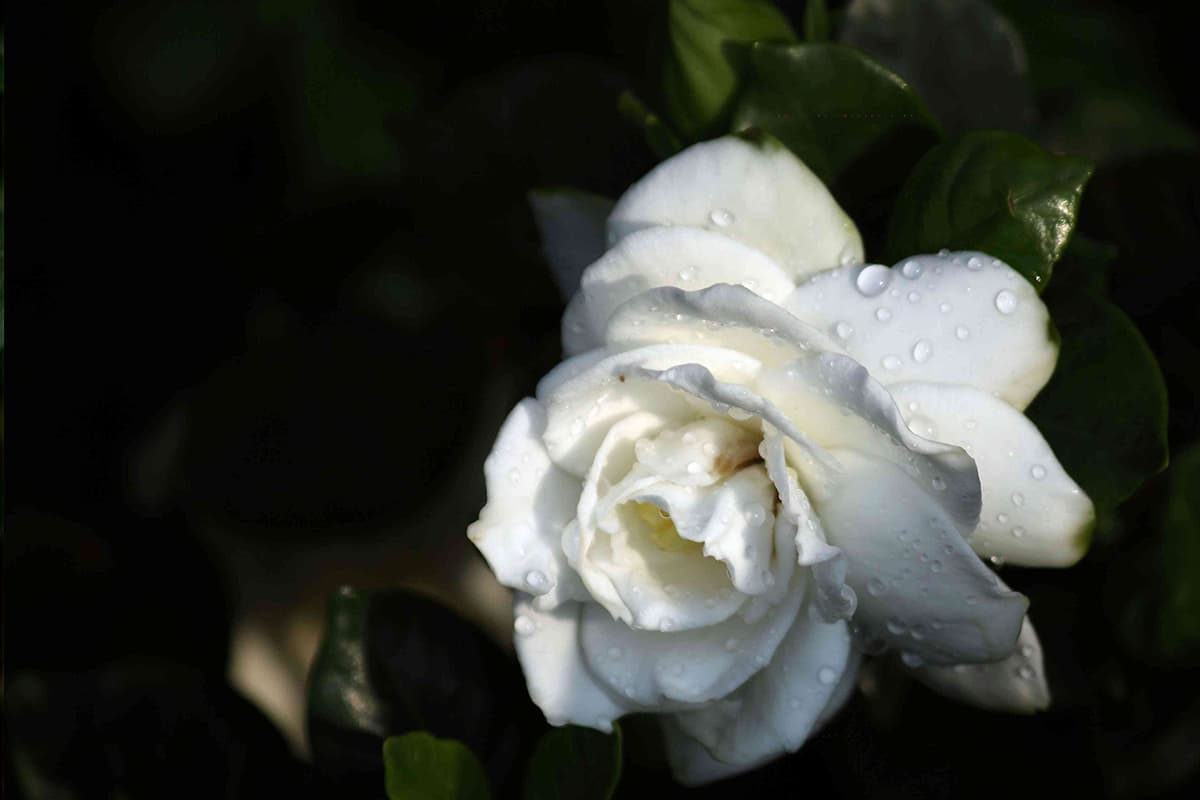
Gardenia jasminoides, commonly known as Cape Jasmine or Gardenia, is an evergreen shrub belonging to the Rubiaceae family. This exquisite plant is prized for its glossy foliage and intensely fragrant, white flowers.
Morphology: The young branches of Gardenia jasminoides are often pubescent, while mature branches are cylindrical and gray. Its leaves are opposite, elliptic-lanceolate to ovate-elliptic, with a leathery texture and dark green, glossy appearance. The striking, creamy-white flowers are solitary, terminal, and highly aromatic. They typically measure 5-10 cm in diameter and have 6-8 overlapping petals. The fruits are ovoid to nearly spherical berries, transitioning from yellow to orange-red as they ripen. Each fruit contains numerous flattened, disk-shaped seeds.
Flowering and Fruiting: In its native habitat, Gardenia jasminoides blooms from March to July, with fruits developing from May of one year to February of the next. However, flowering periods may vary in different climates and with cultivated varieties.
Natural Habitat: Native to southern China and Japan, Gardenia jasminoides naturally occurs in diverse environments, including open fields, hillsides, valleys, mountain slopes, and along streams in forests or shrublands. It thrives at elevations ranging from 10 to 1500 meters above sea level.
Cultivation: Gardenias prefer well-draining, acidic soil (pH 5.0-6.5) rich in organic matter. They require consistent moisture but are susceptible to root rot in waterlogged conditions. These plants thrive in partial shade to full sun, depending on the climate. In cooler regions, they benefit from protection against cold winds and frost.
Propagation: Gardenia jasminoides can be propagated through seeds, though this method is slower and may not produce plants identical to the parent. Vegetative propagation via stem cuttings is more common, ensuring genetic consistency and faster growth.
Medicinal Uses: In traditional Chinese medicine, Gardenia jasminoides fruits (Zhi Zi) are valued for their antipyretic, anti-inflammatory, and diuretic properties. They are used to treat various conditions, including fevers, jaundice, and urinary tract infections. The plant is also believed to help “cool” the blood and detoxify the body.
Culinary and Other Uses: While not commonly used in Western cuisine, Gardenia fruits can be used to create a natural yellow food coloring. In some Asian cultures, the flowers are used to flavor tea or incorporated into pastries. The plant’s intense fragrance makes it popular in perfumery and aromatherapy.
Gardenia jasminoides is a beloved ornamental plant in gardens worldwide, cherished for its beautiful flowers and intoxicating scent. However, it can be challenging to grow, requiring specific conditions and care to thrive. With proper attention to soil pH, moisture levels, and temperature, gardeners can successfully cultivate this stunning shrub and enjoy its beauty and fragrance.
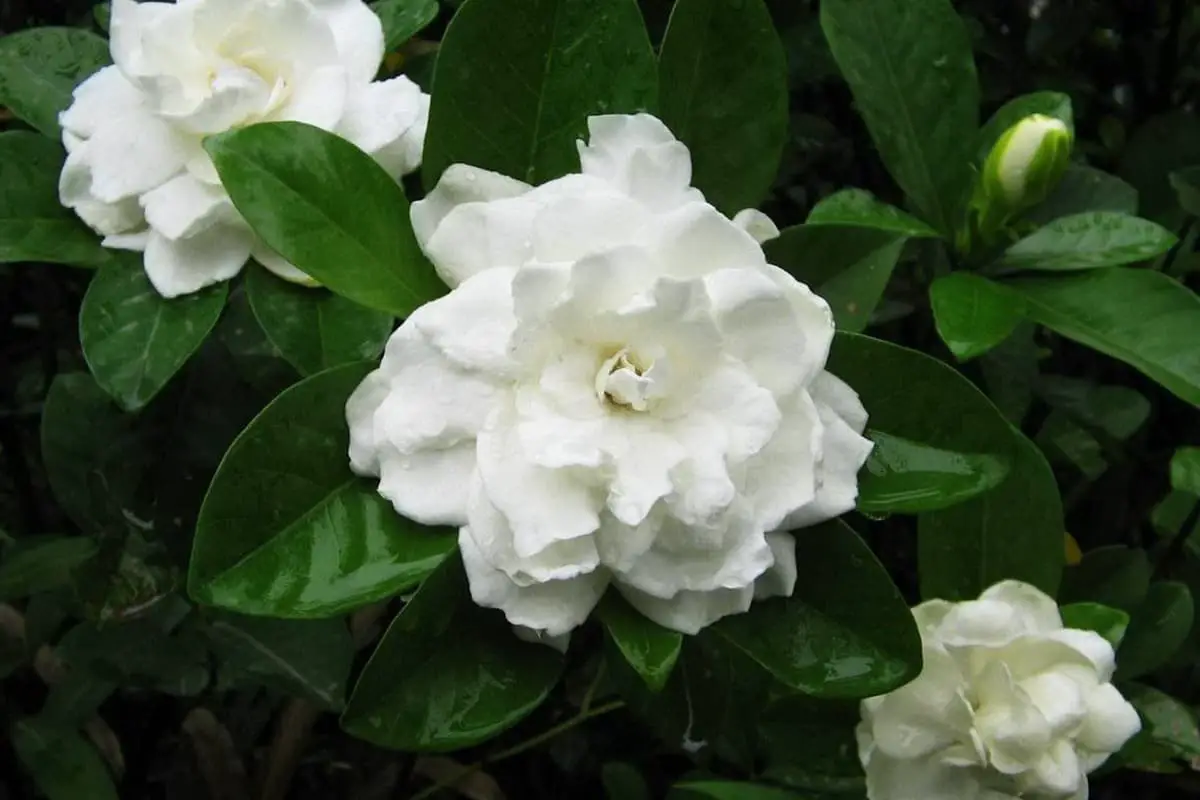
Gardenia jasminoides, commonly known as Cape Jasmine or Large-flowered Gardenia, is an evergreen shrub or small tree belonging to the Rubiaceae (madder) family. This species is prized for its exquisite fragrance and ornamental value in gardens and landscapes.
Morphology:
Phenology:
Native range and habitat preferences:
Cultivation and propagation:
Common cultivars:
Medicinal uses:
Gardening tips:
Gardenia jasminoides is a beloved ornamental plant, cherished for its intoxicating fragrance and elegant white blooms. With proper care and attention to its specific growing requirements, it can be a stunning addition to gardens, patios, and indoor spaces in suitable climates.
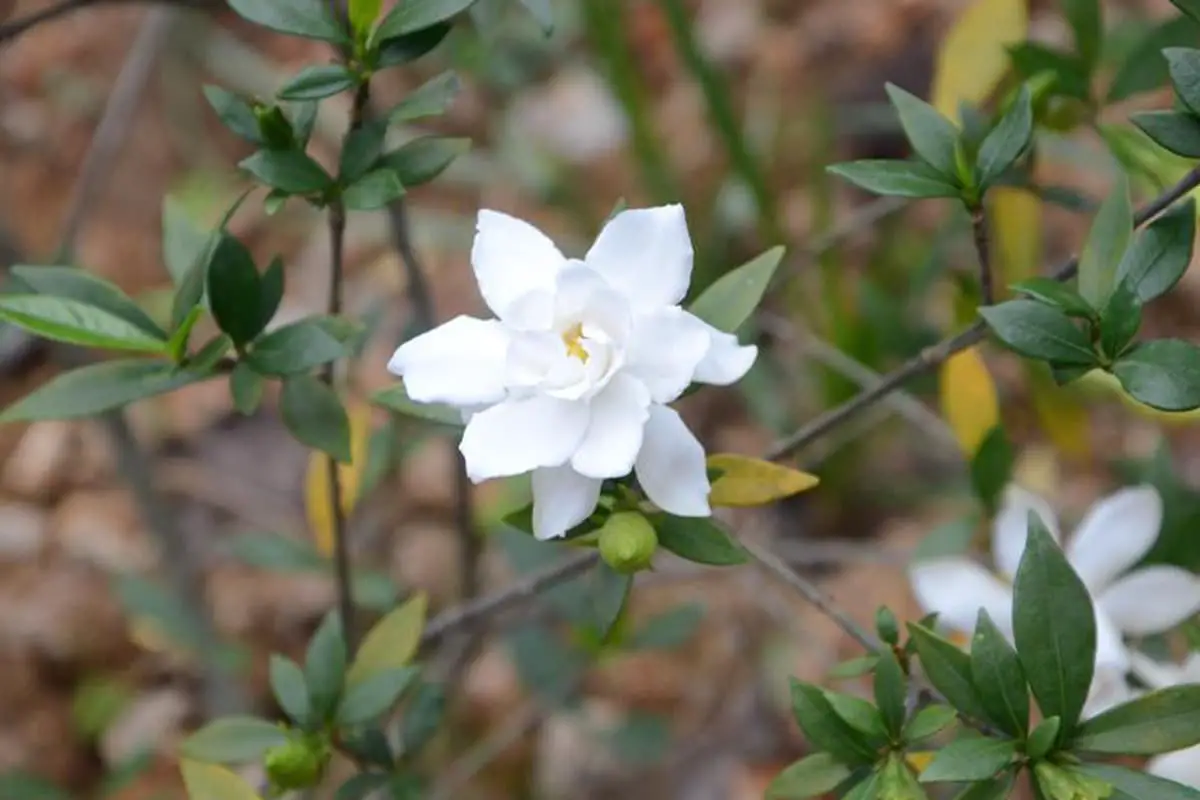
Gardenia jasminoides Ellis, commonly known as Cape Jasmine or Small-leaved Gardenia, is an evergreen shrub or small tree belonging to the Rubiaceae family. This ornamental plant, native to East Asia, typically grows to a height of 1-3 meters (3-10 feet), forming a dense, rounded shape.
The leaves of G. jasminoides are glossy, dark green, and leathery, measuring 5-12 cm long and 3-6 cm wide. They are arranged oppositely on the stem and can be elliptic, obovate, or oblong in shape, with an acuminate or slightly acute apex. The foliage provides an attractive backdrop for the plant’s stunning flowers.
The flowers of G. jasminoides are highly prized for their exquisite beauty and intoxicating fragrance. They are solitary, terminal, and can reach 5-10 cm in diameter. The blooms are typically pure white or creamy yellow, with 6-8 waxy petals arranged in a spiral pattern.
Flowering occurs from late spring to early summer (March to July), with some cultivars capable of reblooming throughout the growing season.
Following pollination, the plant produces fleshy, oval to oblong fruits that are 2-4 cm long. These fruits start green and gradually turn yellow or orange-red as they ripen. Each fruit contains numerous flattened, disc-shaped seeds embedded in a reddish pulp. The fruiting period extends from late summer to early spring of the following year (May to February).
G. jasminoides is widely distributed across southern China, including provinces such as Fujian, Guangdong, Guangxi, and Yunnan. It has also been cultivated extensively in other East Asian countries like Japan, Korea, Vietnam, Laos, and Cambodia. In its natural habitat, it thrives in various environments, including open fields, hillsides, valleys, mountain slopes, and along streams in shrublands or forest edges.
This species prefers warm, humid climates with temperatures between 15-30°C (59-86°F). It requires ample sunlight but can tolerate partial shade, especially in hotter regions. Well-draining, fertile, and acidic soil with a pH between 5.0-6.5 is ideal for optimal growth. Regular watering is essential, but the plant is susceptible to root rot if overwatered or planted in poorly draining soil.
Propagation of G. jasminoides can be achieved through several methods:
G. jasminoides has significant medicinal and cultural importance. In Traditional Chinese Medicine, various parts of the plant are used:
The plant contains several bioactive compounds, including geniposide, gardenoside, and chlorogenic acid, which contribute to its medicinal properties.
In the language of flowers, G. jasminoides symbolizes purity, love, and joy. Its pristine white blooms and captivating fragrance have made it a popular choice for bridal bouquets and wedding decorations, representing eternal love and commitment.
Cultivation of G. jasminoides requires attention to its specific needs:
With its stunning flowers, glossy foliage, and rich cultural significance, Gardenia jasminoides Ellis remains a beloved ornamental plant in gardens and landscapes worldwide, captivating horticulturists and plant enthusiasts alike.

Gardenia jasminoides ‘Radicans’, commonly known as Dwarf Gardenia or Creeping Gardenia, is a compact, low-growing cultivar of the species Gardenia jasminoides, belonging to the Rubiaceae family. This evergreen shrub is prized for its glossy foliage and fragrant flowers.
The leaves of ‘Radicans’ are lanceolate, dark green, and notably smaller than those of the standard Gardenia jasminoides, giving rise to its ‘sparrow’s tongue’ description in some regions. These leaves are arranged oppositely on the stems, creating a dense, attractive foliage.
Flowers are solitary, appearing at the branch tips, and typically measure 5-7 cm in diameter. They feature a white, waxy corolla with 6-8 overlapping petals, creating a pinwheel or star-like appearance rather than a butterfly shape. The blooms are highly fragrant, emitting a sweet, jasmine-like scent that intensifies in the evening.
Flowering occurs primarily from late spring to early summer (May to July), with some sporadic blooming possible throughout warmer months. After flowering, the plant may produce small, oval-shaped fruits that ripen from green to orange-yellow or reddish-orange. These fruits, while ornamental, are not typically consumed.
Native to southern China, Gardenia jasminoides and its cultivars have been widely cultivated in East Asia, including Japan, for centuries. ‘Radicans’ was likely developed through selective breeding for its compact growth habit.
This cultivar prefers partial shade to full sun and thrives in well-draining, acidic soil (pH 5.0-6.5). While it can tolerate brief periods of cold, it is not frost-hardy and is best suited to USDA zones 8-11. In colder regions, it’s often grown as a container plant that can be moved indoors during winter.
Gardenia ‘Radicans’ is versatile in the landscape, suitable for use as a low hedge, border plant, or ground cover. Its compact size (typically 30-60 cm tall and 60-90 cm wide) makes it ideal for small gardens, rock gardens, or as a specimen plant in mixed containers.
Propagation can be achieved through stem cuttings taken in late spring or early summer, layering, or by division of established plants. Seeds can also be used but are less common due to the slow growth and potential genetic variation.
Maintenance includes regular watering to keep the soil consistently moist but not waterlogged, annual fertilization with an acid-forming fertilizer, and periodic pruning to maintain shape and encourage bushiness. Like other gardenias, ‘Radicans’ can be susceptible to pests such as mealybugs, scale insects, and spider mites, as well as fungal diseases in overly humid conditions.
The Dwarf Gardenia’s year-round green foliage, pristine white flowers, and intoxicating fragrance make it a valuable addition to sensory gardens, Mediterranean-style landscapes, and traditional Asian-inspired gardens. Its adaptability and relatively rapid growth for a dwarf cultivar contribute to its popularity among gardeners and landscapers alike.
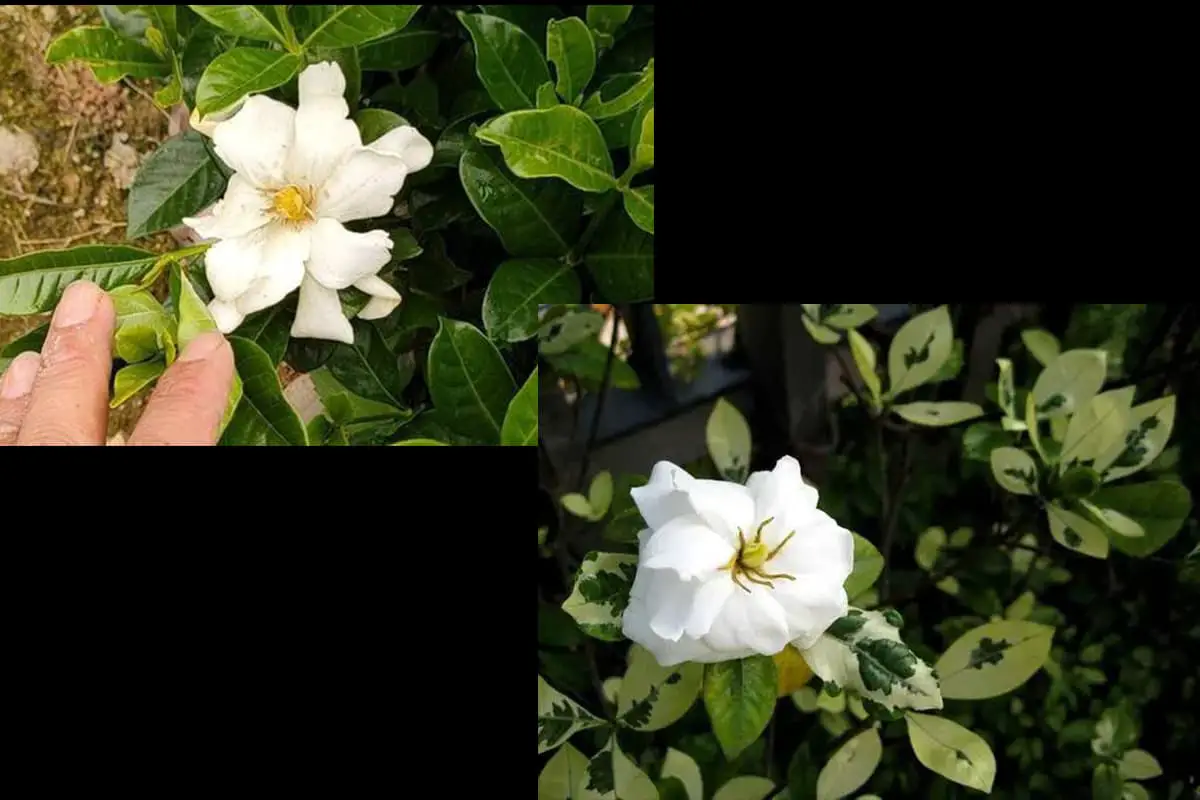
The Gardenia jasminoides ‘Variegata’, commonly known as Variegated Cape Jasmine, is a striking cultivar of the classic Gardenia. This evergreen shrub, belonging to the Rubiaceae family, is prized for its fragrant flowers and ornamental foliage.
Typically reaching heights of 1 to 2 meters, this compact shrub features a gray stem structure complemented by vibrant green twigs. Its leaves, arranged either in opposite pairs or whorls of three, are a distinguishing feature. These leaves are glossy and leathery in texture, occasionally appearing slightly papery. The foliage exhibits a captivating variegation pattern, with a light yellow-green base color adorned with irregular green patches, creating a visually appealing contrast.
The flowers of Gardenia jasminoides ‘Variegata’ are its crowning glory. Pure white and intensely fragrant, these blooms appear either at the branch tips or nestled in the leaf axils. The intoxicating scent, reminiscent of jasmine, makes this plant a favorite for gardens and patios where its aroma can be fully appreciated.
For optimal growth, the Variegated Gardenia thrives in full sun to partial shade, with a preference for morning sun and afternoon shade in hotter climates. It flourishes in temperatures ranging from 18°C to 28°C (64°F to 82°F). This cultivar requires well-draining, organically rich soil with a pH between 5.0 and 6.5. Consistent moisture is crucial, but avoid waterlogging as it can lead to root rot.
The flowering season extends from March to July, with the possibility of sporadic blooming throughout warmer months. Its fruiting period spans from May to the following February, though fruit production may be limited in cultivated specimens.
Propagation of Gardenia jasminoides ‘Variegata’ is typically achieved through vegetative methods to maintain the variegated characteristics. Stem cuttings taken in late spring or early summer, and air layering performed in spring, are the most reliable methods. Rooting hormone can be used to enhance success rates.
Regular pruning after flowering helps maintain shape and encourages bushier growth. This variety may be more susceptible to chlorosis in alkaline soils, so periodic soil pH testing and appropriate amendments are advisable. With proper care, the Variegated Gardenia serves as a stunning specimen plant, hedge, or container feature, offering both visual appeal and olfactory delight to any garden setting.
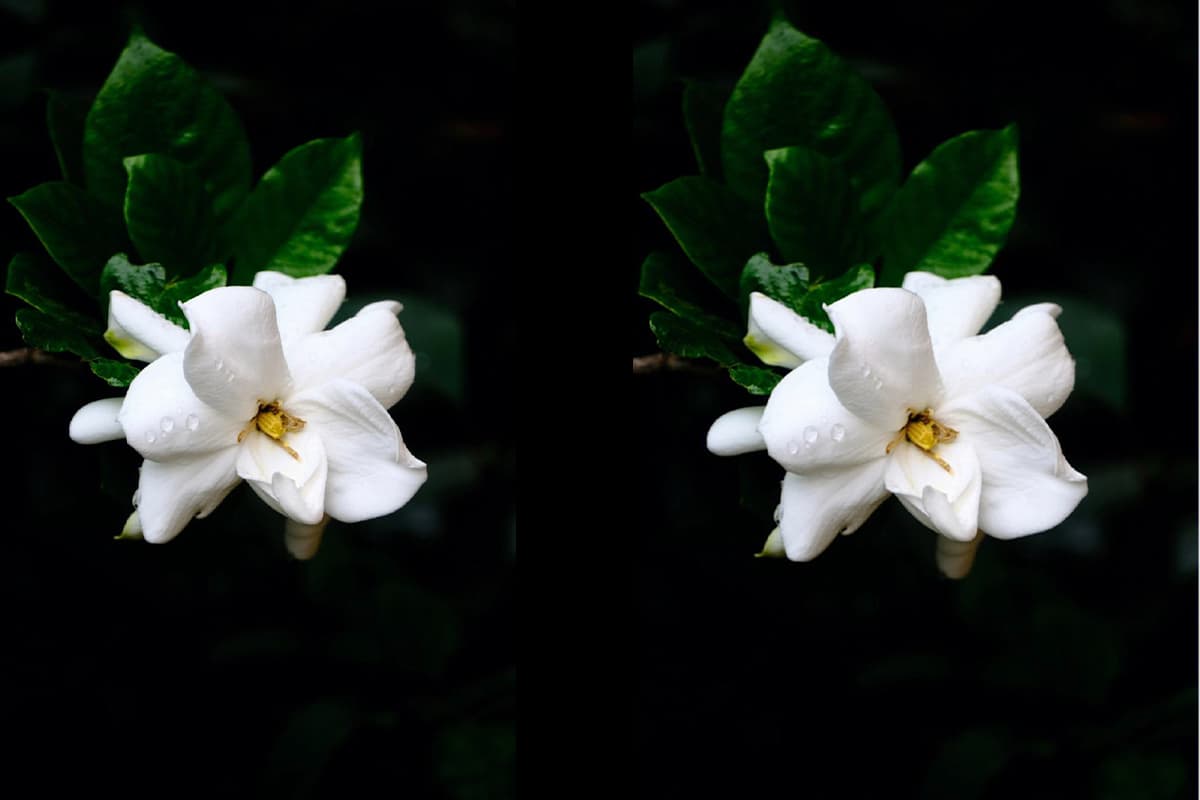
Gardenia jasminoides Ellis, commonly known as Cape Jasmine or Bai Chan in Chinese, is an evergreen shrub belonging to the Rubiaceae family. This species can grow up to 2-3 meters in height, featuring a dense, rounded form with glossy foliage.
The leaves are opposite or arranged in whorls of three, measuring 5-10 cm long and 3-5 cm wide. They are leathery in texture, dark green, and glossy, with an elliptical to ovate-lanceolate shape and entire margins. The stipules, characteristic of the Rubiaceae family, fuse to form a tubular sheath around the stem.
The flowers are solitary, terminal or axillary, and highly fragrant. They are white, sometimes with a creamy tinge, and can reach 5-12 cm in diameter. The calyx is green and tubular, while the corolla consists of 6-8 overlapping petals, forming a rose-like appearance. Flowering occurs from late spring to early summer, typically May to July.
The fruit is a yellow to orange-red berry, ovoid to elongated-ellipsoid in shape, measuring 2-4 cm long. It contains numerous seeds embedded in a soft pulp. Fruit ripening takes place from August to November.
Native to southern China and Japan, Gardenia jasminoides is extensively cultivated throughout subtropical and warm temperate regions. It thrives in bright, indirect light but can tolerate partial shade. The plant prefers a warm, humid climate with temperatures between 15-23°C (59-73°F). It demonstrates moderate cold hardiness, typically withstanding temperatures down to -5°C (23°F) for short periods.
Optimal growing conditions include well-draining, fertile soil with a pH range of 5.0-6.5. The plant is intolerant of alkaline soils, which can lead to chlorosis. While drought-tolerant once established, consistent moisture is crucial for healthy growth and abundant flowering. Gardenia jasminoides shows remarkable resistance to sulfur dioxide pollution, making it suitable for urban landscapes.
Propagation methods include semi-hardwood cuttings taken in summer, air layering in spring, division of established plants, and seed sowing, although the latter is less common due to slow germination and variable results.
The roots and leaves of Gardenia jasminoides have been used in traditional Chinese medicine for centuries. They contain compounds such as geniposide and genipin, which contribute to their medicinal properties. These parts are considered bitter in taste and cooling in nature, with anti-inflammatory, analgesic, and hepatoprotective effects. They are traditionally used to treat various conditions including febrile diseases, jaundice, hepatitis, and urinary tract infections.
In the language of flowers, Gardenia jasminoides symbolizes purity, grace, and secret love. Its pristine white blooms and intoxicating fragrance have made it a popular choice in bridal bouquets and romantic gestures. The flower is also associated with refinement and elegance in many cultures.
Gardenia jasminoides holds special significance in Yueyang City, Hunan Province, China, where it has been designated as the city flower. This status reflects both its natural prevalence in the region and its cultural importance to the local community.

Gardenia sootepensis Hutch., commonly known as Da Huang Zhi Zi, is a tree species belonging to the Rubiaceae family and Gardenia genus. This impressive plant typically reaches heights of 7 to 10 meters and is characterized by its occasional secretion of a gummy substance.
The twigs of G. sootepensis are notable for their distinct nodes, with internodal spaces measuring less than 1 centimeter in length. These spaces are initially densely covered with short, soft hairs (pubescence) that eventually fall off, a process known as glabrescence.
The leaves of this species exhibit variability in both texture and shape. They can be either papery (chartaceous) or leathery (coriaceous) in texture, with shapes ranging from ovate and ovate-elliptical to broad elliptical and oblong. This leaf polymorphism is a common feature in many Gardenia species, often influenced by environmental factors.
The flowers of G. sootepensis are particularly striking, measuring approximately 7 centimeters in diameter. They are fragrant and typically solitary, positioned at the terminal ends of twigs. This positioning is advantageous for pollination and is a characteristic feature of many Gardenia species.
The fruit is a green, elliptical or oblong berry, covered with soft hairs and often featuring 5-6 vertical ridges. These ridges likely aid in seed dispersal. The fruit contains numerous seeds, each nearly round and flat, measuring 3-4 millimeters in diameter. The seeds have a distinctive honeycomb pattern on their surface, which is thought to assist in water absorption during germination.
G. sootepensis has a prolonged flowering period from April to August, with fruiting occurring from June to the following April. This extended reproductive cycle is an adaptation that allows the plant to maximize its reproductive success across varying environmental conditions.
The species is native to Southeast Asia, specifically found in Thailand, Laos, and the Yunnan province of China. It thrives at altitudes between 700 to 1600 meters, preferring habitats on hillsides, near villages, or along streams. This distribution suggests the plant’s adaptability to various microclimates within its range.
G. sootepensis has significant ethnobotanical importance. Its mature fruits are edible, and Dai women have traditionally used it for hair washing, likely due to saponin compounds present in the plant. The fruit is also valued in traditional medicine for treating various ailments, though specific medicinal properties require further scientific investigation.
From a phytochemical perspective, G. sootepensis is noteworthy for its potential as a source of natural dyes. It can be used to extract edible yellow and blue pigments, which could have applications in the food and cosmetic industries.
Ecologically, G. sootepensis is well-suited for planting on barren hills or slopes, serving multiple purposes. As an ornamental plant, it enhances the aesthetic value of landscapes. More importantly, its deep root system and substantial canopy make it valuable for soil stabilization and water conservation, particularly in areas prone to erosion.
In conclusion, Gardenia sootepensis is a versatile species with significant ecological, ethnobotanical, and potential economic value. Its wide-ranging applications, from traditional medicine to environmental conservation, underscore the importance of preserving and studying this remarkable plant.
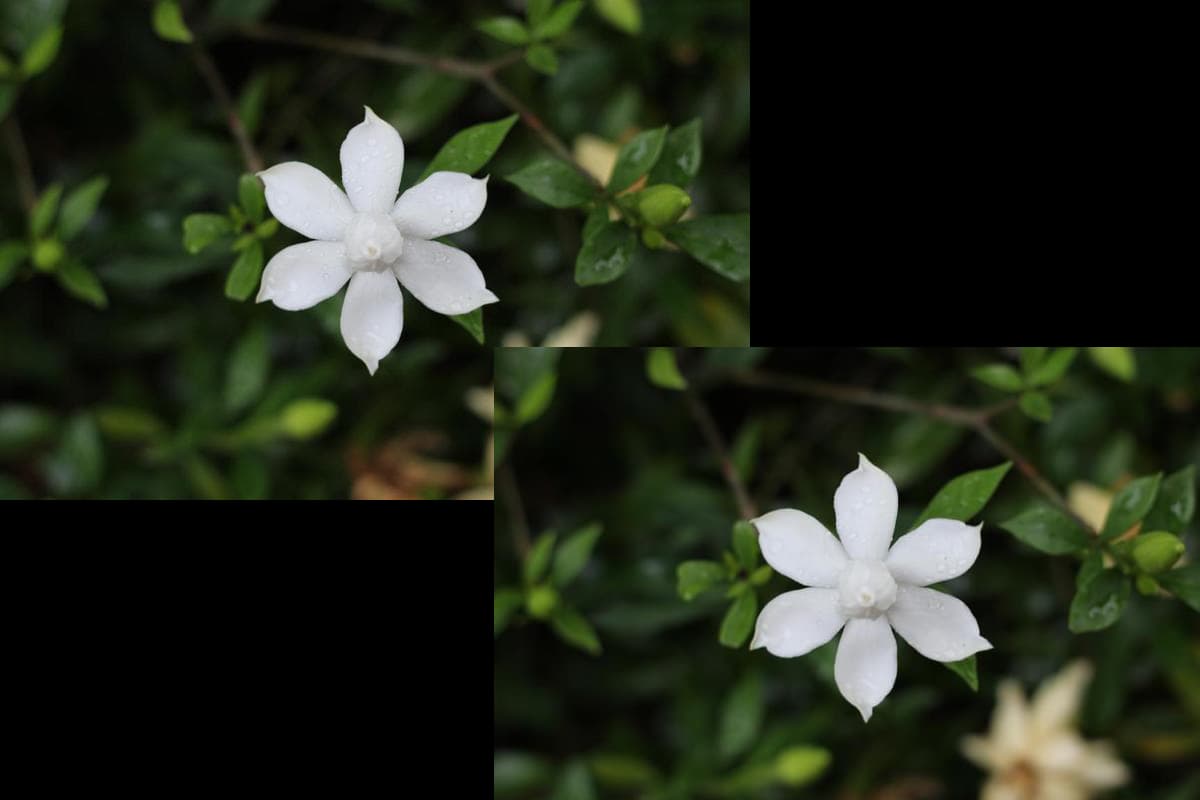
Gardenia stenophylla, commonly known as the Narrow-leaved Gardenia, is a distinctive shrub belonging to the Rubiaceae family. This species is characterized by its slender, leathery leaves that are narrowly lanceolate or linear-lanceolate in shape, tapering to an acuminate apex and attenuate base. The leaves are typically glabrous on both surfaces and exhibit a decurrent habit, with interpetiolar stipules that are membranous in texture.
The inflorescences of G. stenophylla are either solitary and axillary or terminal, producing fragrant flowers that are a hallmark of the Gardenia genus. These blooms appear from April to August, contributing to the plant’s ornamental value during the growing season.
The fruit is an oblong berry with longitudinal ridges, transitioning from green to yellow or orange-red as it ripens. A notable feature is the persistence of the calyx lobes on the mature fruit. The fruiting period extends from May to January of the following year, offering a prolonged period of visual interest.
Endemic to China, the Narrow-leaved Gardenia demonstrates adaptability to various habitats within its native range. It thrives at elevations between 90 and 800 meters above sea level, inhabiting diverse ecological niches including valley floors, riparian zones, forest understories, and open areas adjacent to watercourses. The species shows a particular affinity for rocky substrates, preferring locations that offer ample sunlight and good air circulation while benefiting from some protection against intense, direct sunlight.
Propagation of G. stenophylla can be achieved through several methods, including stem cuttings, layering, division of established plants, and seed sowing. Each technique has its advantages, allowing for flexibility in cultivation and propagation strategies.
The Narrow-leaved Gardenia’s compact growth habit, evergreen foliage, and attractive floral display make it an excellent subject for bonsai cultivation. This art form can accentuate the plant’s natural grace and aesthetics.
Beyond its ornamental value, G. stenophylla has traditional medicinal applications. Various parts of the plant, particularly the fruits and roots, are utilized in traditional Chinese medicine for their purported cooling, anti-inflammatory, and detoxifying properties. These traditional uses have sparked interest in the plant’s phytochemical composition.
Scientific investigations have revealed a complex array of bioactive compounds within G. stenophylla. Phytochemical analyses have identified several classes of compounds, including:
This diverse chemical profile underscores the potential for further pharmacological research and possible applications in modern medicine or nutraceuticals.
In conclusion, Gardenia stenophylla is a multifaceted species that combines horticultural appeal with ecological adaptability and potential medicinal value. Its cultivation in appropriate climates can contribute to landscape diversity, while its phytochemical properties warrant continued scientific exploration.
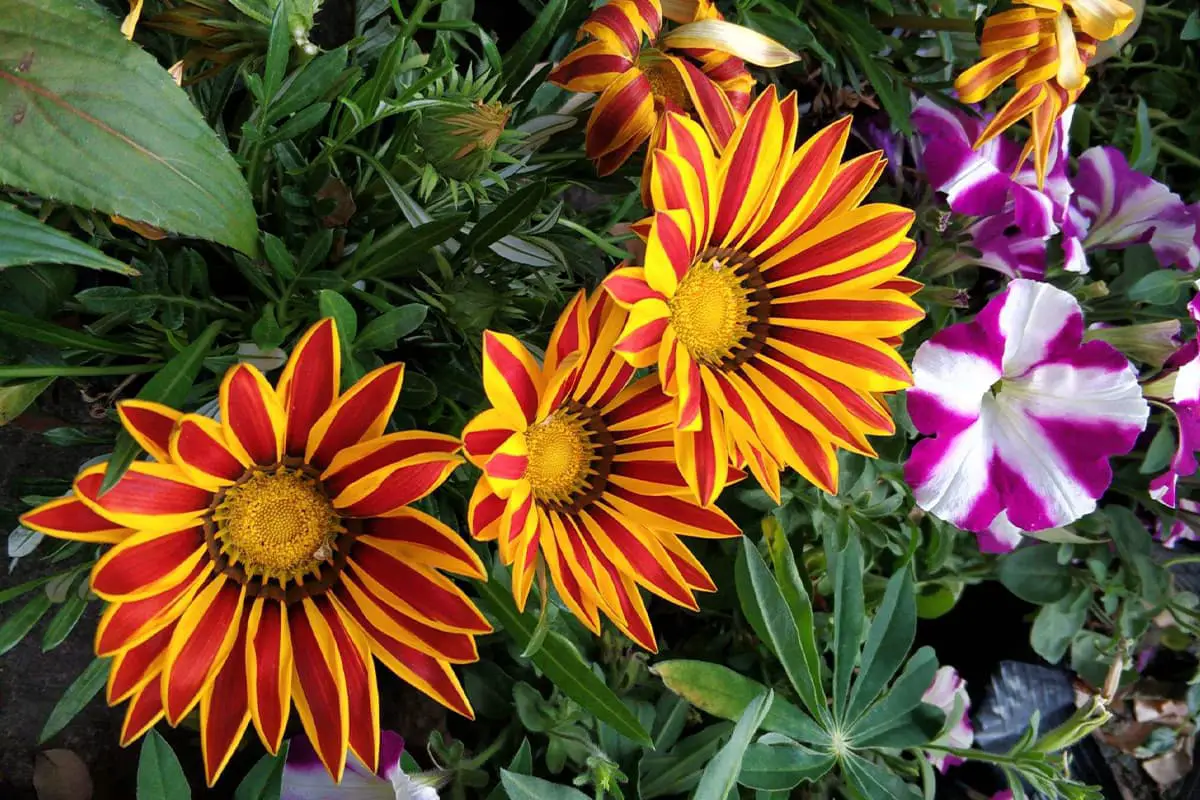
Gazania rigens, commonly known as the Treasure Flower or Coastal Gazania, is a striking perennial herbaceous plant belonging to the Asteraceae family. This sun-loving species typically grows to a compact height of 15-30 cm (6-12 inches), forming dense mats of foliage.
The leaves of Gazania rigens are distinctive, featuring a lanceolate shape that can be entire or pinnatisect (deeply lobed). The upper surface of the leaves is a rich green, while the undersides are covered with a silvery-white tomentum, providing an interesting contrast and adaptation to drought conditions.
The flower heads of Gazania rigens are large and daisy-like, measuring 5-8 cm (2-3 inches) in diameter. They exhibit a remarkable range of colors, including vibrant shades of yellow, orange, red, pink, and white, often with striking dark bands or spots at the base of the ray florets. These intricate patterns, resembling medals or coins, have earned the plant its colloquial name “Treasure Flower” or “Medal Flower” in some regions.
Flowering occurs from late spring through summer and can extend into autumn in favorable conditions. The flowers open in bright sunlight and close at night or during overcast weather, a phenomenon known as nyctinasty.
Native to the coastal regions and grasslands of South Africa, Gazania rigens has been widely cultivated and naturalized in many parts of the world with similar Mediterranean or temperate climates. In China, it has been successfully introduced in cities such as Shenyang, Jinzhou, and Chengde. It has also become naturalized in parts of Australia, where it is sometimes considered an invasive species in coastal areas.
Gazania rigens thrives in full sun and well-drained soils. It displays remarkable drought tolerance and can survive in poor, sandy soils, making it an excellent choice for xeriscaping. While it prefers warm conditions, it also exhibits moderate cold hardiness, typically surviving temperatures down to -5°C (23°F) in dormancy.
Propagation of Gazania rigens can be achieved through several methods:
In landscaping, Gazania rigens is versatile and can be used effectively in various settings:
The cultural significance of Gazania rigens extends beyond its ornamental value. Its nickname “Medal Flower” in some cultures symbolizes honor, achievement, and radiant glory, making it a meaningful gift or decorative element in celebratory contexts.
In conclusion, Gazania rigens is a resilient and visually striking plant that offers long-lasting color with minimal care, making it an excellent choice for both novice and experienced gardeners in suitable climates.
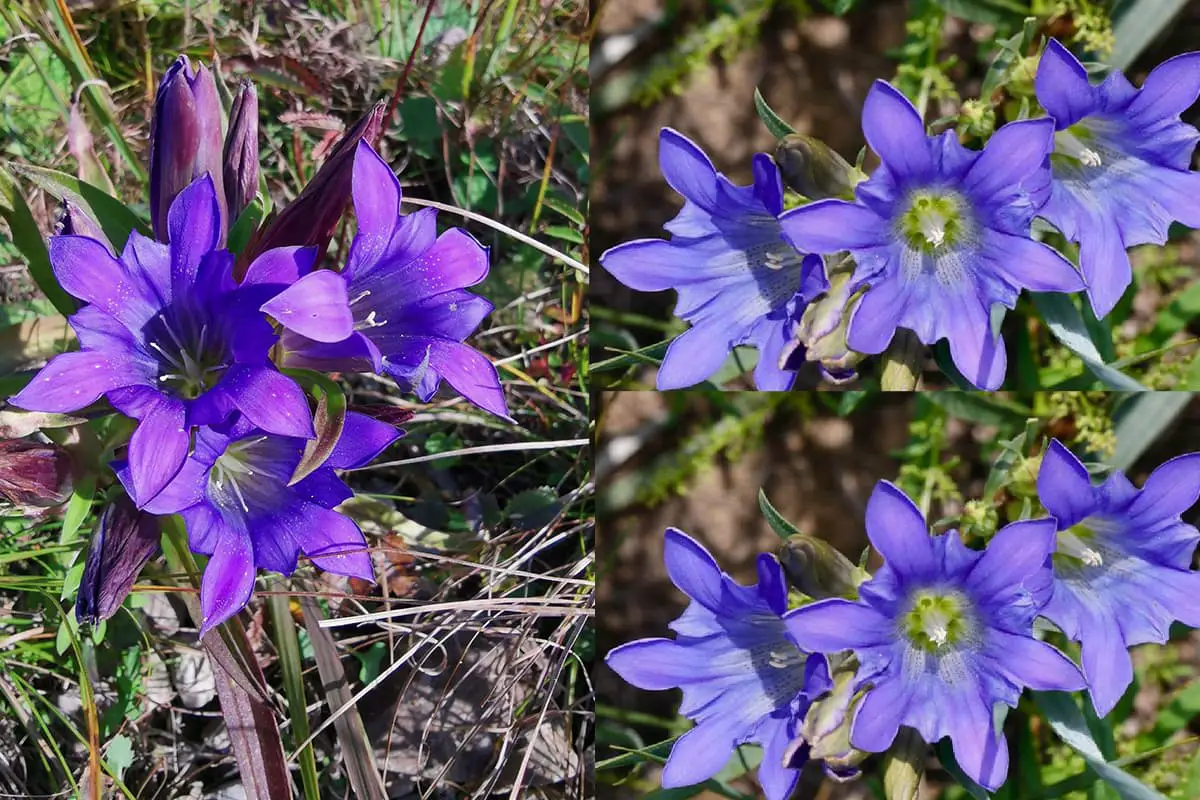
Gentiana Dahurica, commonly known as Dahurian Gentian, is a perennial herbaceous plant belonging to the Gentianaceae family. This hardy species typically grows to a height of 25-40 centimeters, with its branches forming dense, clustered growth patterns.
The plant’s basal leaves are lanceolate to linear-ovate in shape, featuring an acuminate apex and an attenuate base. These leaves are characterized by broad, flattened petioles. In contrast, the stem leaves are linear-lanceolate to strictly linear, exhibiting a more slender profile.
Inflorescences of Gentiana Dahurica are terminal or axillary, boasting distinctive calyx tubes that are membranous in texture. These tubes display a yellow-green coloration, often suffused with purplish-red hues. The calyx is notable for its uncleft, irregular structure and linear form.
The corolla of the Dahurian Gentian is a striking deep blue, occasionally adorned with yellow maculations in the throat. Its lobes are ovate to elliptic-ovate, with obtuse apices and entire margins, contributing to the flower’s elegant appearance.
The plant’s fruit is a capsule, concealed within the persistent calyx. These capsules are lanceolate to linear in shape and sessile. The seeds they contain exhibit a delicate reticulate pattern, an important characteristic for identification and taxonomic classification.
Gentiana Dahurica follows a specific phenological pattern, with flowering occurring in July and fruit development from August to September. This timing is crucial for its reproductive success and adaptation to its native habitats.
Endemic to China, the Dahurian Gentian demonstrates remarkable ecological versatility. It thrives across a wide altitudinal range, from 870 to 4,500 meters above sea level. Its preferred habitats include meadows, roadsides, riparian zones, lacustrine sandy shores, ditch margins, sun-exposed slopes, and xeric grasslands. This adaptability underscores the species’ resilience and importance in various ecosystems.
In traditional Chinese medicine, Gentiana Dahurica is valued for its therapeutic properties. The plant is characterized by a bitter and pungent taste, and is considered neutral in nature according to traditional classification. Its medicinal applications are diverse, including the ability to dispel wind and dampness (concepts in traditional Chinese medicine), alleviate deficient heat, and mitigate myalgia.
Clinically, Gentiana Dahurica has been employed in the treatment of several conditions. These include tonsillitis, urticaria, cutaneous anthrax, and rheumatoid arthritis. However, it’s important to note that while traditional uses are well-documented, modern scientific research continues to investigate the efficacy and safety of these applications.
The Dahurian Gentian not only serves as a valuable medicinal herb but also plays a significant role in its native ecosystems. Its presence in varied habitats contributes to biodiversity and potentially supports local wildlife. As with many wild species, conservation efforts are crucial to ensure the sustainability of Gentiana Dahurica populations, especially in the face of habitat loss and climate change.
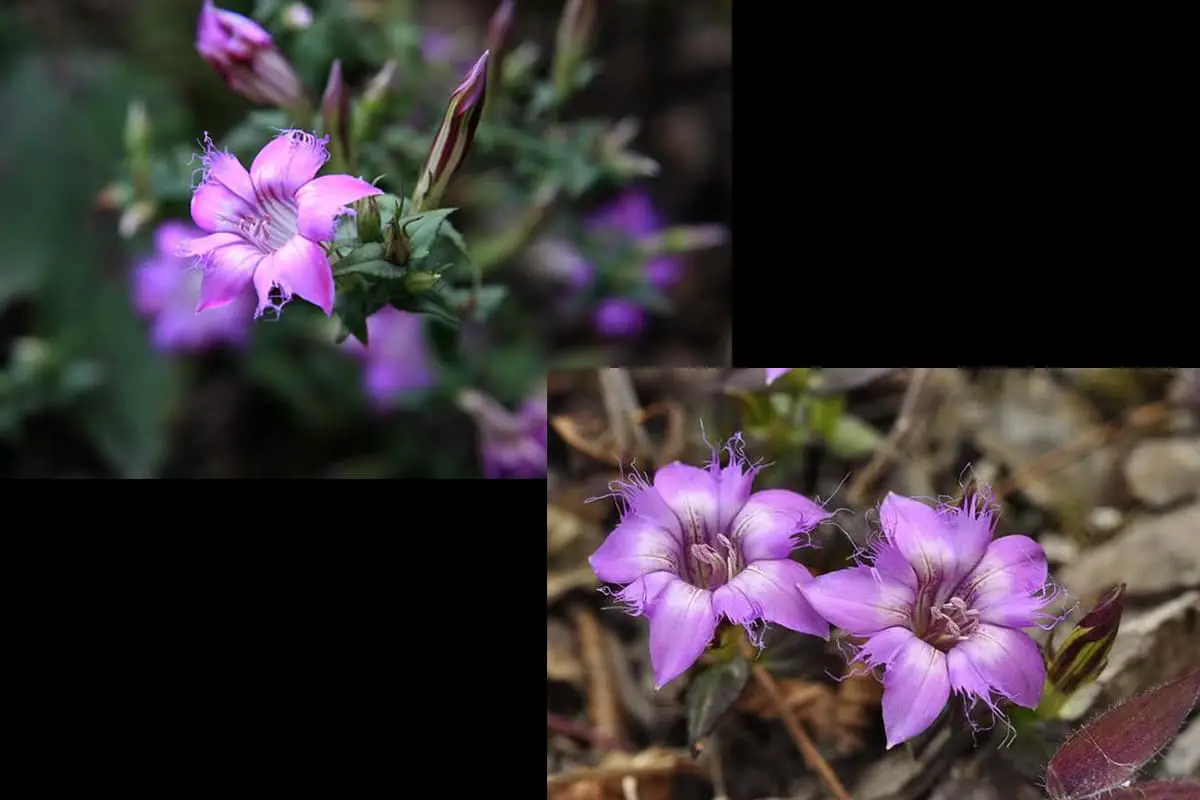
Gentiana rhodantha, commonly known as Red-flowered Gentian, is a perennial herbaceous plant belonging to the Gentianaceae family. This species showcases remarkable adaptability and distinctive characteristics that set it apart in its genus.
The plant’s morphology is diverse, with stems that can be solitary or form clusters, often branching towards the apex. The leaves exhibit variability in shape, ranging from oval and ovate to egg-shaped. Notably, the stem leaves are characteristically broad ovate or triangular-oval, a feature that aids in species identification.
Flowers of G. rhodantha are borne singly at the stem apex, displaying the vibrant red coloration that gives the species its common name. The fruit is an elongated oval capsule, containing seeds with a distinctive netted pattern, which is crucial for taxonomic classification within the Gentiana genus.
This gentian species has a prolonged reproductive period, with flowering and fruiting occurring from October through February of the following year. This extended season is an adaptation that allows the plant to maximize its reproductive success in its native high-altitude habitats.
G. rhodantha is endemic to China, thriving in diverse ecological niches including high mountain shrublands, alpine grasslands, and the understory of montane forests. Its ability to reproduce effectively in these wild habitats underscores its ecological importance in these high-altitude ecosystems.
From a phytochemical perspective, G. rhodantha possesses a bitter taste, which is characteristic of many gentian species due to the presence of secoiridoid glycosides. In traditional Chinese medicine (TCM), it is classified as having a cold nature, aligning with its use in treating heat-related conditions.
The medicinal applications of G. rhodantha are diverse, targeting multiple organ systems. In TCM, it is associated with the liver, gallbladder, lung, and large intestine meridians. Its primary therapeutic actions include:
These medicinal properties are attributed to the plant’s rich phytochemical profile, which likely includes compounds common to the Gentiana genus such as gentiopicroside, swertiamarin, and other bioactive constituents.
The cultivation and conservation of G. rhodantha are of particular interest due to its endemic status and medicinal value. Sustainable harvesting practices and potential cultivation efforts are crucial to ensure the species’ survival and continued availability for medicinal use, while also preserving its ecological role in China’s high-altitude ecosystems.
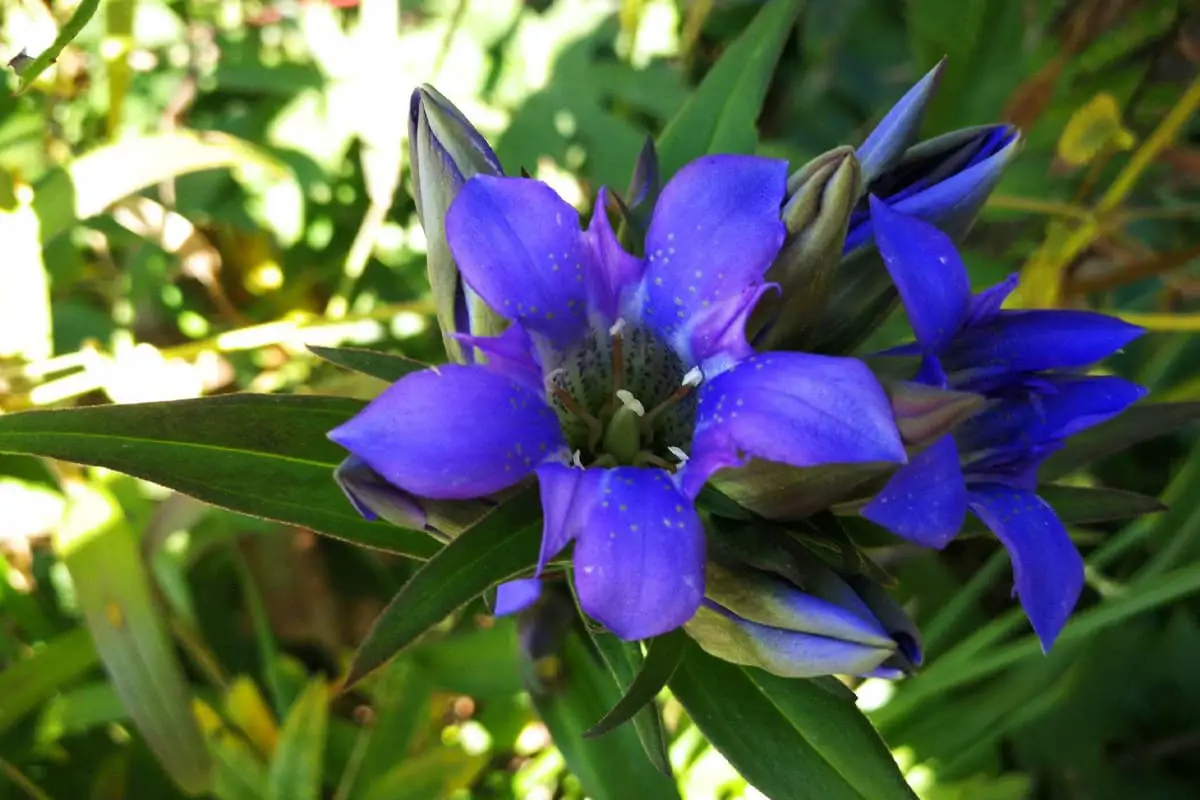
Gentiana scabra Bunge, commonly known as the Japanese gentian or rough gentian, is a significant species in the genus Gentiana and an important component of traditional East Asian medicine. In Tibetan pharmacopeia, it is referred to as “Bangjian.”
According to the “Jingzhu Materia Medica,” this plant possesses potent therapeutic properties, particularly effective against toxic conditions and various febrile diseases. It is frequently utilized in traditional medicine to treat respiratory ailments such as bronchitis and coughs, as well as infectious diseases like smallpox.
The natural habitat of Gentiana scabra spans across East Asia, including mainland China, eastern Russia, Japan, and the Korean Peninsula. It thrives in diverse ecosystems, from lowland meadows to montane regions, typically growing at elevations ranging from 400 to 1,700 meters above sea level.
China boasts an impressive diversity of Gentiana species, with over 240 documented taxa. The majority of these species are concentrated in the southwestern mountainous regions, while only a few are found in the vicinity of Beijing and the Qilian mountain area.
Gentiana scabra is a hardy perennial herb, exhibiting cold resistance and a preference for full sun, although it can tolerate partial shade. It flourishes in deep, fertile, well-draining sandy loam soils. The plant typically grows to a height of 30-60 cm, featuring an erect stem that remains unbranched towards the apex.
The leaves of Gentiana scabra are simple and arranged oppositely on the stem, lacking petioles (sessile). The basal leaves are relatively small, while the mid to upper stem leaves vary from ovate to lanceolate in shape. These leaves are characterized by their rounded bases that clasp the stem.
The flowers of Gentiana scabra are one of its most distinctive features. They are funnel-shaped and exhibit a striking deep blue coloration. The flowering period typically occurs from late summer to early autumn, between August and September.
In traditional Chinese medicine, the root and rhizome of Gentiana scabra, known as “Longdan” or “dragon’s gall,” are highly valued for their medicinal properties. These plant parts are renowned for their bitter taste and are primarily used for their heat-clearing (clearing internal heat) and damp-drying (removing excess dampness) properties in the body.
Cultivation of Gentiana scabra requires attention to its specific growing requirements. The plant benefits from a location that receives full morning sun but is protected from intense afternoon heat. Soil pH should be slightly acidic to neutral (6.0-7.0), and consistent moisture is crucial, although waterlogged conditions should be avoided. Propagation can be achieved through seeds, division, or stem cuttings, with seed stratification often necessary to improve germination rates.
As with many medicinal plants, sustainable harvesting practices are essential to ensure the conservation of wild populations of Gentiana scabra. Increasing interest in traditional medicine has led to the development of cultivation methods to meet demand while protecting natural ecosystems.
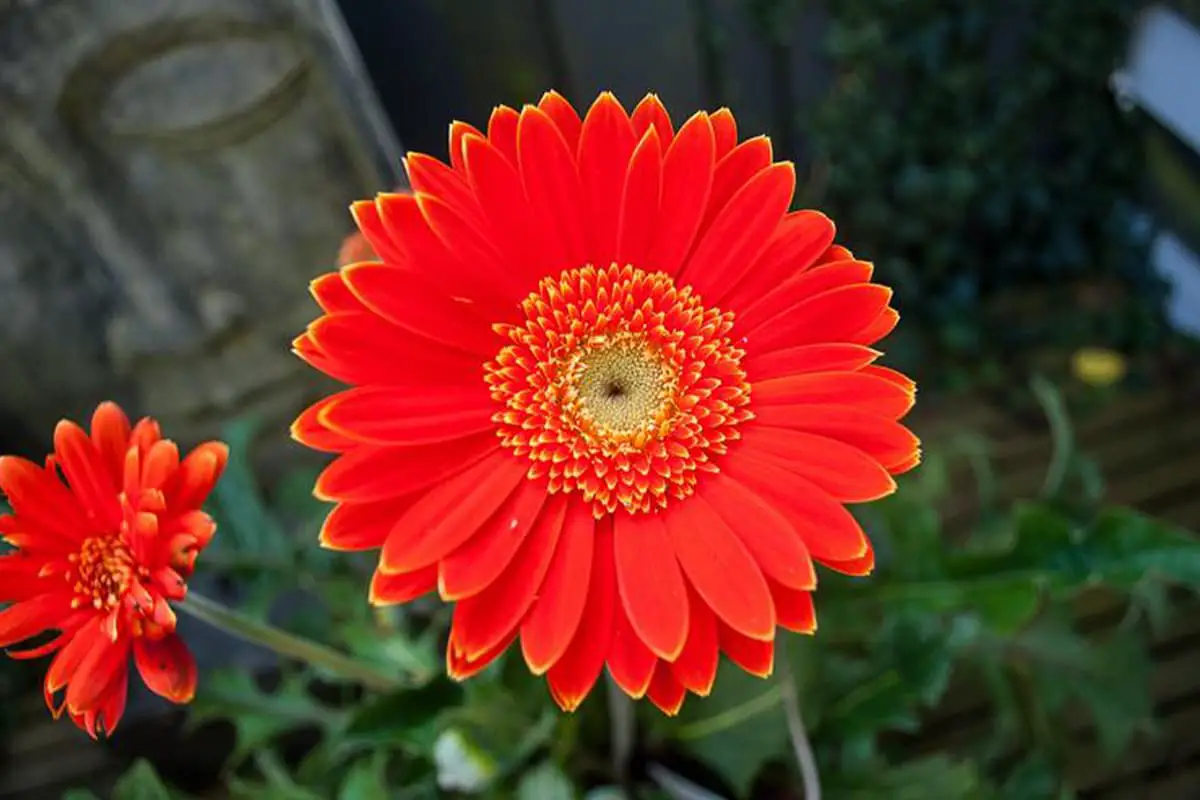
Gerbera jamesonii, commonly known as the Transvaal daisy or Barberton daisy, is a species of flowering plant in the family Asteraceae. This perennial, herbaceous plant is prized for its vibrant, daisy-like flowers and is widely cultivated for both ornamental and commercial purposes.
Native to South Africa, particularly the Mpumalanga region (formerly Transvaal), G. jamesonii thrives in warm, sunny environments with well-drained soil. The plant features a compact rhizomatous rootstock surrounded by fibrous roots, which contribute to its drought tolerance and perennial nature.
The leaves of G. jamesonii form a basal rosette and are characterized by their long, lobed shape. These leaves can range from 15 to 25 cm in length and are typically dark green with a slightly hairy texture. The leaf margins are often serrated or deeply incised, adding to the plant’s ornamental value even when not in bloom.
The flower stalks, or scapes, emerge directly from the leaf rosette and can reach heights of 40-60 cm. Each scape bears a single, large flower head (capitulum) that can measure 7-12 cm in diameter. The inflorescence consists of ray florets surrounding a central disc of smaller florets, creating the classic daisy-like appearance.
One of the most striking features of G. jamesonii is its wide range of flower colors. Cultivars have been developed to produce blooms in various shades of red, pink, orange, yellow, white, and even bicolor combinations. This diversity has made the Gerbera a favorite among florists and gardeners alike.
The flowering period of G. jamesonii is extensive, typically spanning from spring through autumn in temperate climates. In its native habitat and in areas with mild winters, it may bloom nearly year-round, with peak flowering occurring from November to April.
G. jamesonii has been extensively bred for the cut flower industry, resulting in numerous cultivars with improved vase life, stem strength, and color variety. These developments have made Gerberas the fifth most popular cut flower globally, following roses, carnations, chrysanthemums, and tulips.
In cultivation, G. jamesonii prefers well-draining, slightly acidic soil (pH 5.5-6.5) and requires regular watering without waterlogging. The plants benefit from moderate fertilization during the growing season to promote continuous blooming. While generally robust, they can be susceptible to fungal diseases in humid conditions, making proper air circulation essential.
Beyond its ornamental value, G. jamesonii has shown potential in phytoremediation studies, demonstrating an ability to absorb and accumulate certain heavy metals from contaminated soils. This characteristic not only highlights the plant’s environmental applications but also underscores the importance of sourcing Gerberas from reputable growers when used for cut flowers or as edible decorations.
In conclusion, Gerbera jamesonii stands out as a versatile and visually striking plant, valued for its long-lasting, colorful blooms. Its adaptability to various growing conditions and its significance in the floriculture industry ensure its continued popularity in gardens, floral arrangements, and scientific research.
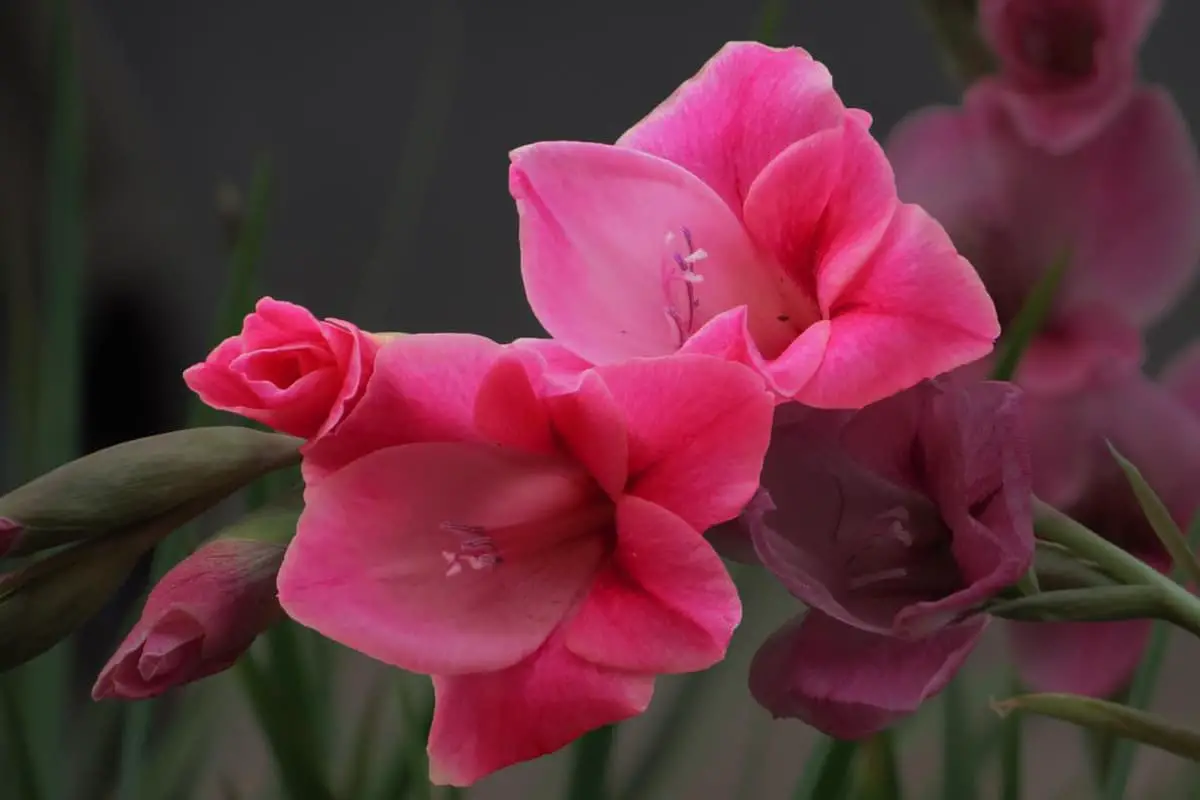
Gladiolus gandavensis is a complex hybrid cultivar group within the Iridaceae family, developed from various Gladiolus species. The corm (often mistakenly called a bulb) is flattened and circular, encased in a papery, brown to yellow-brown tunic. The flower spike is typically unbranched, bearing multiple florets, and the fruit is a dehiscent capsule, either oval or ovoid in shape.
The seeds are flat and winged, adapted for wind dispersal. This gladiolus hybrid blooms from mid-summer to early fall, generally from July to September, with fruit ripening from August to October. The common name “sword lily” refers to its long, sword-like leaves, which bear a resemblance to those of sweet flag (Acorus calamus), leading to its Chinese name meaning “Tang gladiolus.”
Originating from complex hybridization of species native to South Africa, Gladiolus x gandavensis has been widely cultivated and naturalized in Mediterranean climates and parts of Western Asia. It thrives in full sun and warm conditions, displaying moderate cold tolerance but susceptibility to extreme heat and poor drainage.
This gladiolus hybrid prefers rich, well-aerated, sandy loam soils with excellent drainage. Propagation methods include corm division, cormlet production, tissue culture, and less commonly, seed sowing for breeding purposes.
Gladiolus x gandavensis is highly valued in the cut flower industry due to its striking, colorful spikes. It’s also popular in container gardening, suitable for sunny locations such as windowsills, balconies, and roof gardens. In landscape design, it’s often used in borders, beds, and as a vertical accent in mixed plantings.
Interestingly, Gladiolus x gandavensis exhibits sensitivity to hydrogen peroxide, potentially serving as a bioindicator for environmental monitoring. This characteristic could be valuable in assessing air quality or presence of certain pollutants.
While not commonly used medicinally, some traditional practices utilize gladiolus corms. The stems and leaves contain vitamin C, and the corm has been used in folk medicine for its purported anti-inflammatory and circulatory benefits. However, it’s important to note that medicinal use of ornamental plants should only be under professional guidance, as many parts of gladiolus can be toxic if ingested.
In horticulture, Gladiolus x gandavensis requires regular watering, well-balanced fertilization, and protection from strong winds. Proper corm storage during dormancy and vigilance against common gladiolus pests and diseases, such as thrips and Fusarium corm rot, are essential for successful cultivation of these magnificent flowers.
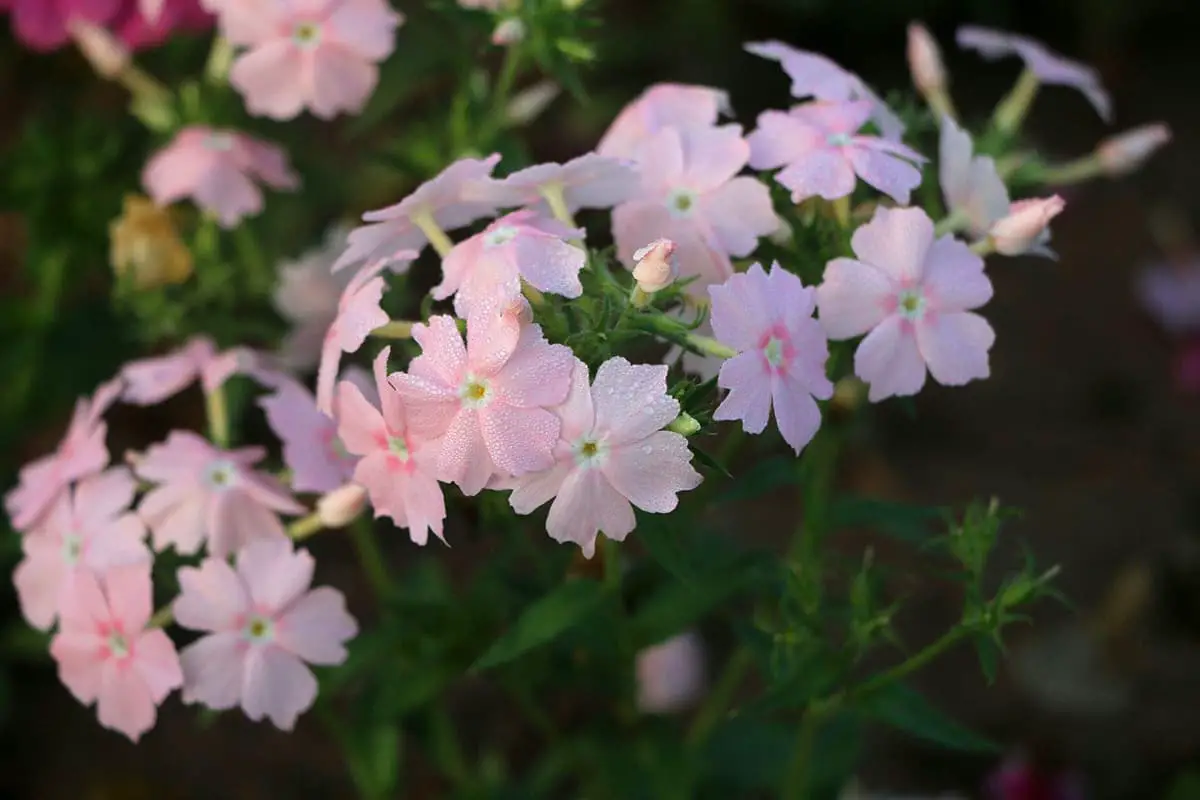
Glandularia hybrida, commonly known as “Hybrid Verbena” or “Garden Verbena,” is a perennial herbaceous plant belonging to the Verbenaceae family. Native to South America, this species thrives in temperatures ranging from 5°C to 25°C (41°F to 77°F).
The plant produces clusters of small, flat-topped flowers in a wide array of vibrant colors, including white, red, blue, purple, pink, and various bi-color combinations. Its long blooming period extends from late spring through fall, typically May to November, making it a popular choice for continuous garden color.
Glandularia hybrida is versatile in its applications. It excels in flower beds, borders, and landscaping designs, where its low-growing, spreading habit creates attractive ground cover. Its cascading nature also makes it ideal for hanging baskets, window boxes, and container gardens on patios or balconies.
While often grown as a tender perennial in warmer climates (USDA zones 8-11), it’s frequently treated as an annual in colder northern regions due to its limited cold tolerance. The plant thrives in full sun exposure, which promotes robust growth and prolific blooming. It prefers well-draining soil and moderate moisture, as it’s susceptible to root rot in overly wet conditions.
Glandularia hybrida demonstrates remarkable heat tolerance, continuing to bloom even during hot summer months. However, it’s less tolerant of drought and deep shade, which can lead to reduced flowering and leggy growth.
In traditional medicine, various Glandularia species have been used for their potential anti-inflammatory and analgesic properties. However, it’s important to note that medicinal use should only be under professional guidance.
The flower language associated with Glandularia hybrida symbolizes unity, cooperation, and family harmony, making it a thoughtful choice for gifting or planting in communal spaces.
To maintain its compact form and encourage continuous blooming, regular deadheading and occasional light pruning are beneficial. With proper care, Glandularia hybrida rewards gardeners with a long-lasting display of colorful blooms, attracting butterflies and hummingbirds to the garden throughout the growing season.
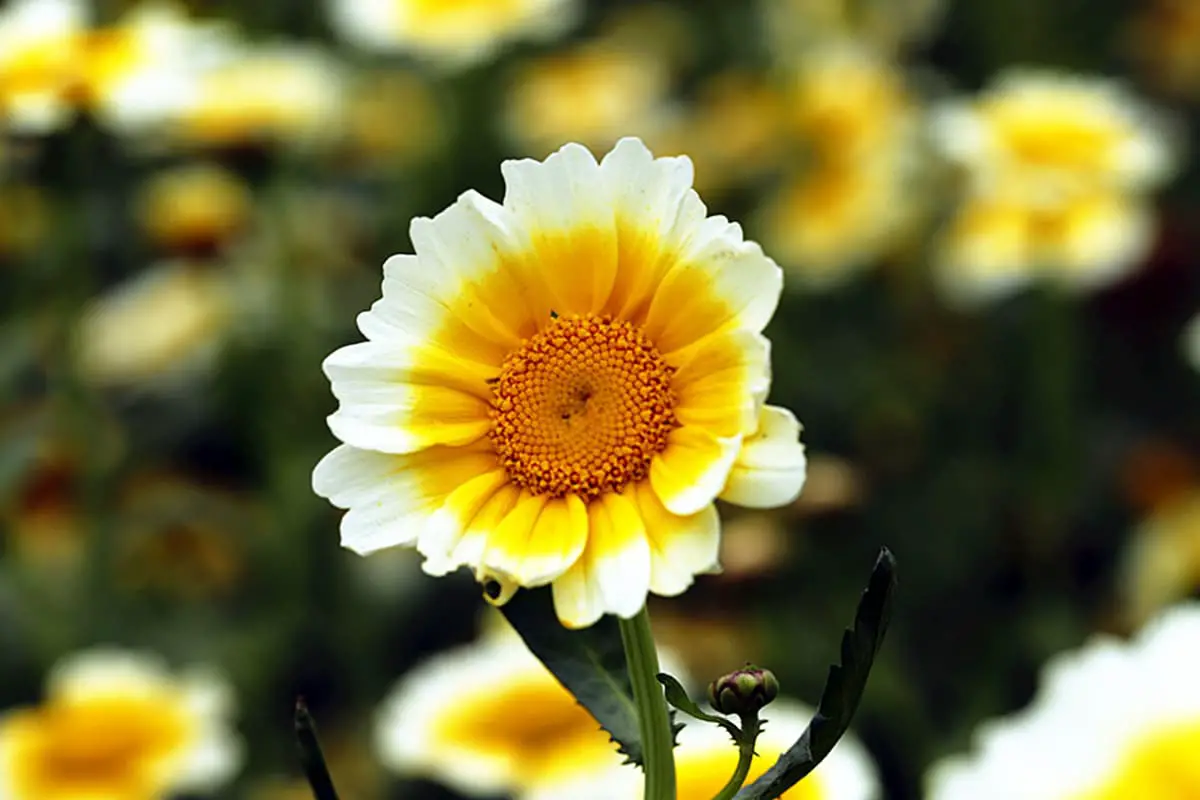
Glebionis coronaria, commonly known as Crown Daisy or Chrysanthemum Greens, is an annual or biennial herbaceous plant belonging to the Asteraceae family. This versatile plant can grow up to one meter tall, featuring an erect, smooth, and succulent stem.
The leaves of G. coronaria are sessile, arranged oppositely along the stem, and exhibit a distinctive pale green color. They are elliptical in shape with deeply serrated margins, giving the plant a lush, ornamental appearance. The flower heads are solitary and terminal, comprising small, densely packed yellow or white florets surrounded by ray flowers, characteristic of the daisy family.
Propagation of Crown Daisy is primarily through seeds, typically sown in late summer (August or September). Its historical significance is evident in its nickname “Emperor’s Vegetable,” attributed to its introduction to royal cuisine.
Native to the Mediterranean region, G. coronaria has been cultivated in China since ancient times, with records dating back to before the Tang Dynasty (618-907 CE). This long history of cultivation has led to its widespread integration into Chinese cuisine and traditional medicine.
Crown Daisy thrives in cool climates and demonstrates remarkable frost tolerance. However, it is sensitive to high temperatures, with optimal growth occurring between 12°C and 29°C. As a long-day plant, it benefits from extended daylight hours but is not overly demanding in terms of light intensity. This adaptability allows for year-round cultivation, especially in southern China.
The plant prefers fertile, well-draining soils with good moisture retention capacity. Loamy or clay-loam soils rich in organic matter are ideal for its cultivation. While originally a wild species, extensive cultivation has led to the development of various cultivars suited to different growing conditions.
In traditional Chinese medicine, Crown Daisy is valued for its balanced nature and therapeutic properties. It is considered sweet and mildly pungent in flavor, and is believed to possess blood-purifying, heart-nourishing, and lung-moistening qualities. The plant is also credited with expectorant properties, aiding in the reduction of phlegm.
Nutritionally, G. coronaria is a rich source of vitamins, particularly vitamins A and C, as well as essential amino acids. These compounds contribute to its reputation for supporting cardiovascular health, cognitive function, and blood pressure regulation. The plant’s distinctive aroma, attributed to its volatile oil content, is known to stimulate appetite.
While generally safe for consumption, it’s important to note that excessive intake of Crown Daisy is not recommended for individuals prone to diarrhea due to its potential laxative effects.
In culinary applications, Crown Daisy is a popular spring vegetable in southern Chinese cuisine, prized for its unique flavor and versatility in various dishes. Its cultivation and use have expanded beyond China, making it a valuable crop in many parts of Asia and beyond.
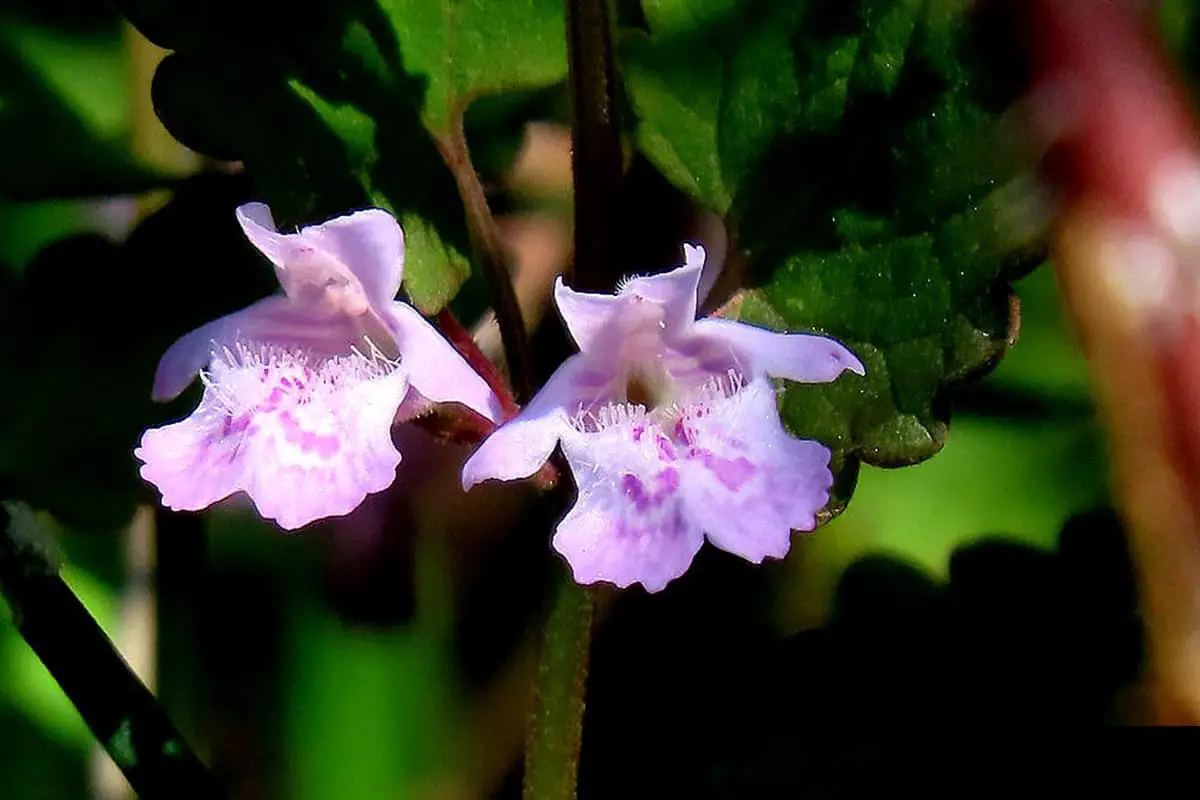
Glechoma Longituba, a member of the Lamiaceae family, is a perennial herb known by various colloquial names including “Gold Coin Herb,” “Piercing Bone Herb,” and “Wind Through Wall.” This versatile plant is prized for both its ornamental value and medicinal properties.
Morphologically, Glechoma Longituba is characterized by its creeping stems that ascend and root at the nodes. The stems typically reach heights of 10-30 centimeters and are distinctly quadrangular. At the base, they often display a pale purple-red coloration. The plant’s overall appearance is nearly glabrous, with sparse, long, soft hairs present on younger growth.
The leaves of Glechoma Longituba are opposite, petiolate, and kidney-shaped to cordate. They measure 1-3 cm in length and 1.5-4 cm in width, with crenate margins and a rounded apex. The leaf surface is sparsely pubescent, particularly along the veins.
Flowering occurs from April to June, producing small, tubular flowers that are typically blue-purple in color. These flowers are arranged in axillary whorls, with 1-3 flowers per axil. The calyx is tubular with five teeth, while the corolla is bilabiate, measuring 15-25 mm in length.
In traditional Chinese medicine, Glechoma Longituba is valued for its spicy flavor and cool nature. It is utilized both internally and externally for various therapeutic purposes. Its medicinal properties include:
Ecologically, Glechoma Longituba thrives in shaded and moist environments. It is commonly found in habitats such as:
This adaptable herb grows across a wide altitudinal range, from as low as 50 meters to elevations of up to 2000 meters above sea level.
Geographically, Glechoma Longituba has a widespread distribution across much of China, with notable exceptions being Qinghai, Xinjiang, and Tibet. Its range extends beyond China, encompassing parts of Russia and North Korea.
For cultivation, Glechoma Longituba prefers well-draining, fertile soil rich in organic matter. It thrives in partial shade to full shade conditions and requires consistent moisture. In garden settings, it can be used as a ground cover, in rock gardens, or as a cascading plant in hanging baskets. Regular pruning helps maintain its shape and prevents excessive spread.
In conclusion, Glechoma Longituba is a multifaceted herb that offers both aesthetic appeal in landscaping and significant value in traditional medicine. Its ability to thrive in various environments and its diverse applications make it a noteworthy plant in both horticultural and medicinal contexts.
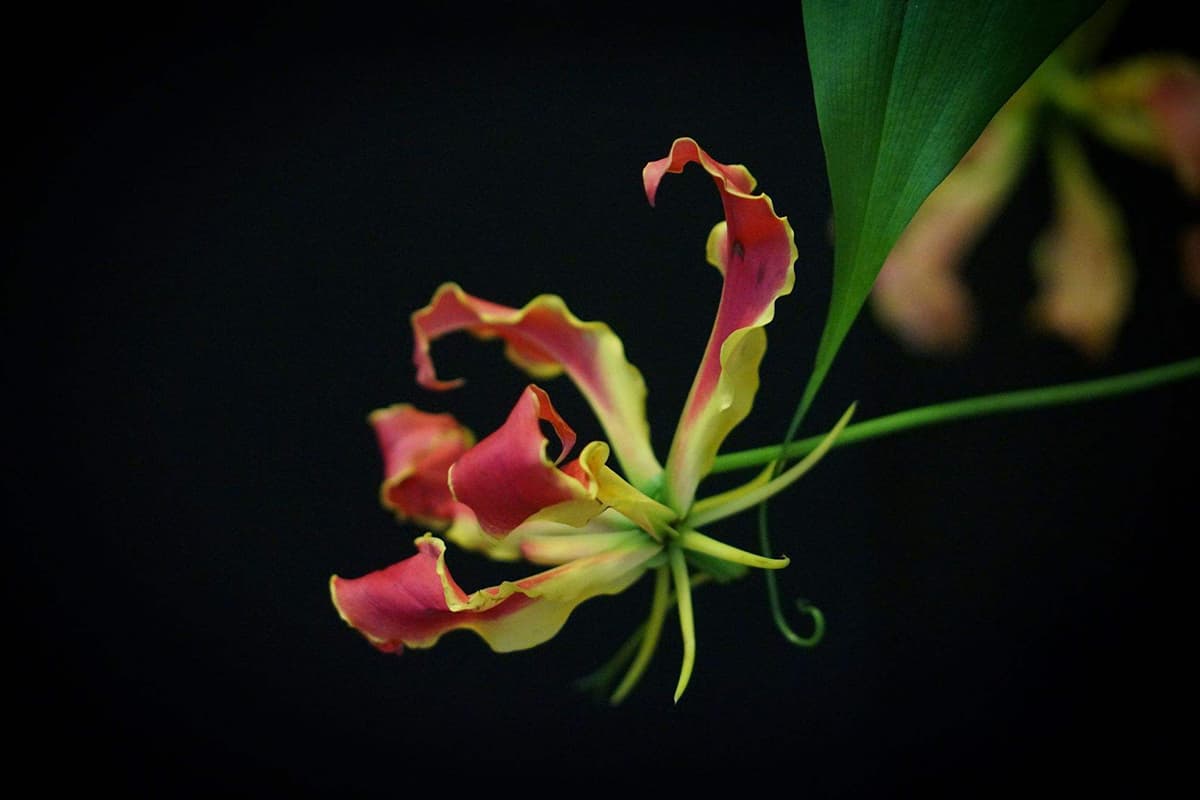
Gloriosa superba, commonly known as the Glory Lily or Flame Lily, is a striking perennial climbing plant belonging to the Colchicaceae family, formerly classified under Liliaceae. This species is renowned for its vibrant flowers and medicinal properties.
The plant develops from horizontal, tuberous rhizomes that are pale yellow-brown and typically 15-20 cm long. These rhizomes are bifurcated or V-shaped, with new growth sprouting from the apex. The above-ground stem is slender, flexible, and can grow up to 5 meters in length, either unbranched or with minimal branching.
Gloriosa superba leaves are sessile or short-stalked, arranged alternately along the stem. They are ovate to lanceolate, 6-20 cm long and 1-4 cm wide, with a bright green color. A distinctive feature is the leaf tip, which extends into a tendril-like structure, allowing the plant to climb and support itself.
The flowers are truly spectacular, measuring 5-7.5 cm in diameter. They appear either solitary or in sparse, umbel-like cymes at the stem tips. Each flower has six tepals that are initially yellow-green, maturing to a brilliant red with yellow margins. The tepals are strongly reflexed and distinctively wavy, creating a flame-like appearance. Flowering typically occurs from July to November, though this can vary depending on local climate conditions.
Native to tropical and southern Africa and tropical Asia, including India and parts of Southeast Asia, Gloriosa superba has been introduced to many other tropical and subtropical regions. It thrives in warm, humid environments with temperatures between 20-30°C (68-86°F), preferring fertile, well-draining soil with a pH of 5.5-6.5. While it appreciates bright, indirect light, it requires protection from intense, direct sunlight. The plant is not frost-hardy and cannot tolerate temperatures below 10°C (50°F) for extended periods.
Propagation of Gloriosa superba is primarily achieved through division of the rhizomes or by seed. When propagating by division, it’s crucial to ensure each section has at least one growing point. Seeds should be sown fresh, as they lose viability quickly.
The entire plant, particularly the tubers, contains high levels of colchicine and other alkaloids, making it highly toxic if ingested. Despite its toxicity, Gloriosa superba has significant medicinal value when used properly. In controlled medical settings, colchicine extracted from the plant is used to treat gout, familial Mediterranean fever, and certain types of cancer. It’s also employed in plant breeding to induce polyploidy.
In various cultures, Gloriosa superba holds symbolic significance. Its striking appearance has led to its association with passion, glory, and fire in many traditions. In Hindu mythology, the flower is linked to Karthikeya, the god of war. The Glory Lily is the national flower of Zimbabwe and the state flower of Tamil Nadu in India.
Cultivation of Gloriosa superba requires care due to its specific needs and toxicity. It’s often grown as an ornamental in tropical gardens or in greenhouses in cooler climates. When cultivating this species, it’s essential to use gloves and take precautions to prevent accidental ingestion, especially in households with children or pets.
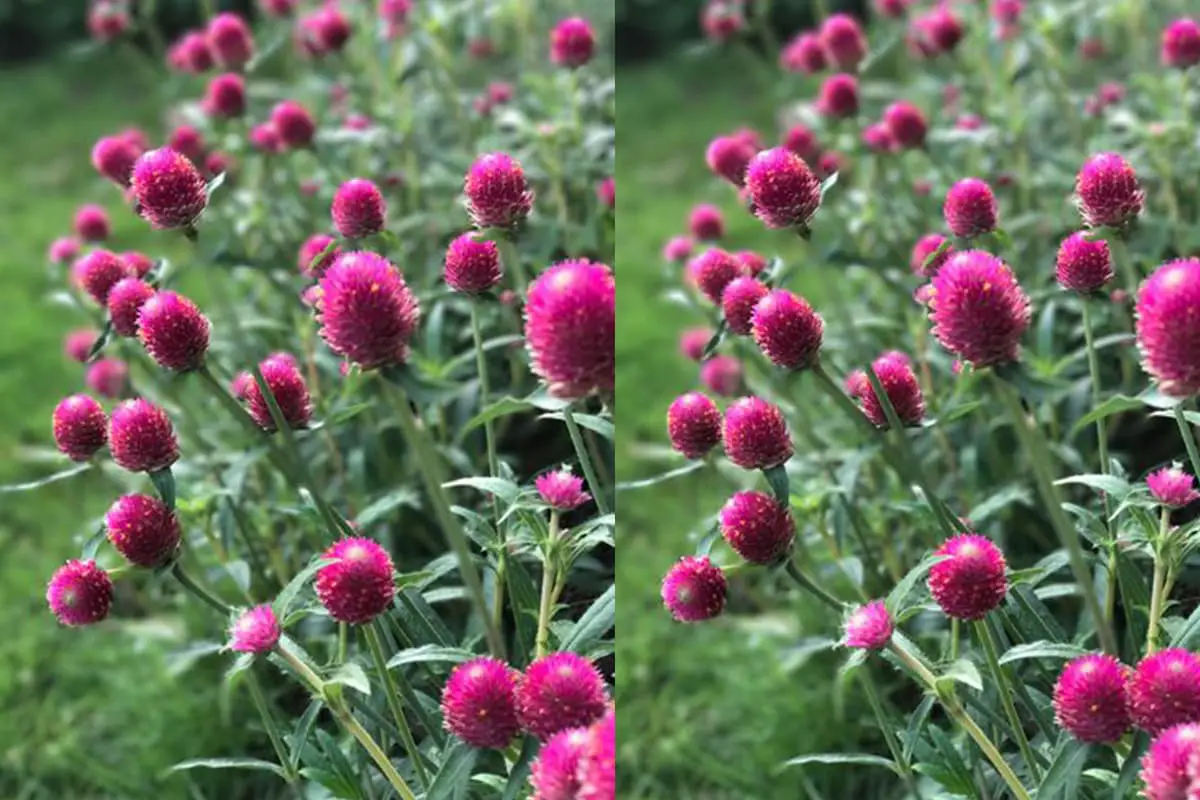
Gomphrena globosa, commonly known as Globe Amaranth or Bachelor’s Button, is an annual herbaceous plant belonging to the family Amaranthaceae. This versatile species, native to Central and South America, has gained popularity worldwide for its ornamental and medicinal properties.
The plant exhibits a robust, erect growth habit, typically reaching heights of 30-60 cm (1-2 ft). Its stem is sturdy and branching, with the branches displaying a distinctive quadrangular shape. Both stems and branches are adorned with coarse, gray trichomes (plant hairs), which are particularly dense on younger growth, providing the plant with a slightly silvery appearance.
Globe Amaranth’s leaves are simple, opposite, and sessile or short-petioled. They are papery in texture, with shapes ranging from oblong-ovate to elliptic, measuring 2-10 cm (0.8-4 in) long. The leaf margins are entire, and the surface is often pubescent, mirroring the hairiness of the stems.
The plant’s most striking feature is its vibrant inflorescences, which bloom prolifically from early summer (June) through fall (September or October in some climates). These globular flower heads, measuring 2-3 cm (0.8-1.2 in) in diameter, comprise numerous small, perfect flowers.
Each flower is subtended by papery bracts, which contribute significantly to the overall color of the inflorescence. While the most common color is a vivid magenta-purple, cultivars now offer a spectrum including white, pink, orange, and red.
One of the most remarkable characteristics of Gomphrena globosa is its ability to retain its color and form long after being cut and dried, earning it the moniker “Everlasting Flower” or “Thousand Days Red” in some cultures. This quality makes it highly prized in dried flower arrangements and crafts.
Globe Amaranth thrives in full sun exposure and is renowned for its heat and drought tolerance, making it an excellent choice for xeriscaping and low-maintenance gardens. It performs best in well-draining, moderately fertile soils with a pH range of 6.1 to 7.8. While adaptable, it is intolerant of waterlogged conditions and cold temperatures, with frost being particularly detrimental.
Propagation is typically achieved through seed sowing or stem cuttings. Seeds can be directly sown outdoors after the last frost or started indoors 6-8 weeks before the last expected frost date. Stem cuttings root readily in moist soil or water, offering a quick method to multiply desirable varieties.
In traditional medicine, particularly in Asian and South American cultures, various parts of the Globe Amaranth have been utilized. The flower heads are most commonly employed, often brewed into teas or decoctions. They are believed to possess expectorant, anti-inflammatory, and hepatoprotective properties. Traditional uses include:
While these traditional uses are intriguing, it’s important to note that scientific research on the medicinal properties of Gomphrena globosa is limited, and more studies are needed to confirm its efficacy and safety for medicinal use.
In ornamental horticulture, Globe Amaranth is prized for its long flowering period, lasting up to 8 weeks, and its versatility in garden design. It’s excellent for borders, mass plantings, container gardens, and as a cut flower. The plant’s compact habit and drought tolerance make it ideal for rock gardens and xeriscapes. Its enduring nature in both fresh and dried forms has led to its symbolic association with unfading love, often used in wedding bouquets and decorations.
In conclusion, Gomphrena globosa is a multifaceted plant that combines ornamental appeal, cultural significance, and potential medicinal value. Its ease of cultivation, striking appearance, and adaptability to various growing conditions ensure its continued popularity in gardens worldwide.
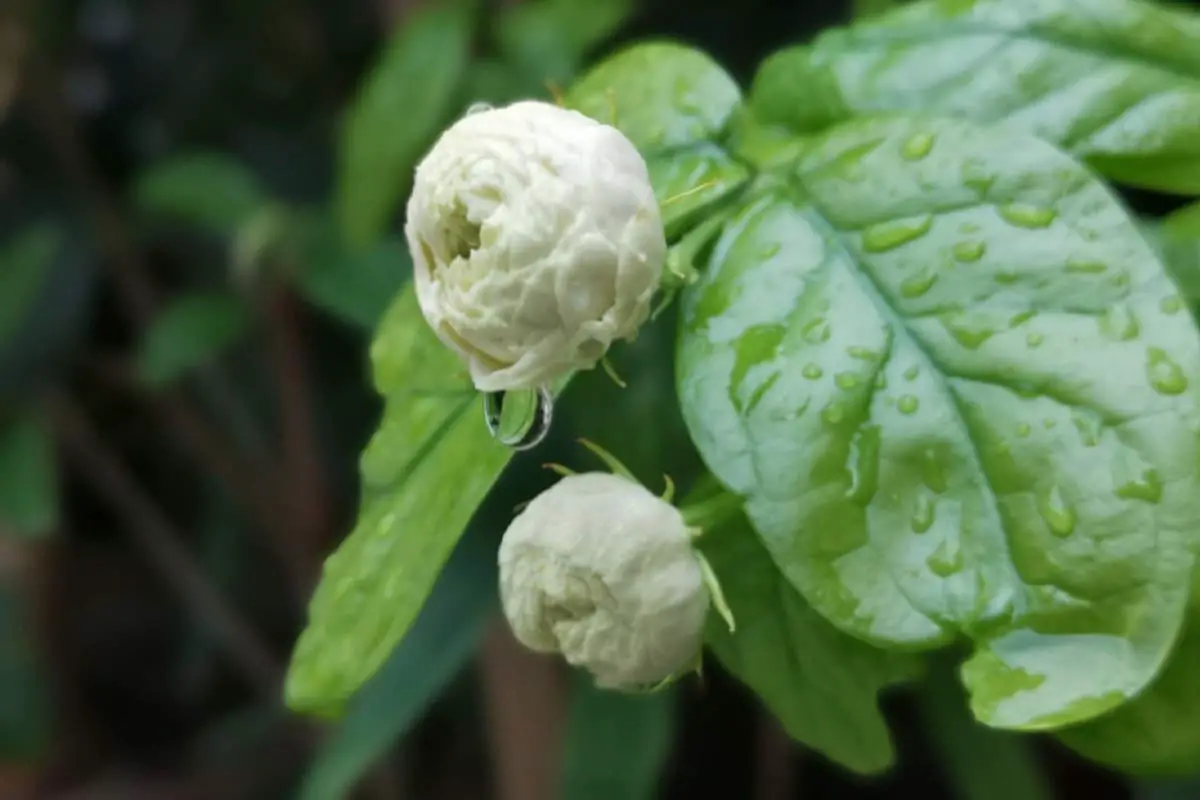
Grand Duke Of Tuscany (Jasminum sambac ‘Grand Duke of Tuscany’) is a cultivar of Arabian jasmine in the Oleaceae family. This cultivar is known for its genetic instability, which can lead to mutations in its floral characteristics.
Like other Jasminum sambac cultivars such as ‘Belle of India’ (also known as ‘Baozhu’) and ‘Maid of Orleans’ (sometimes called ‘Chrysanthemum Jasmine’), it belongs to the double-flowered category. One of the challenges in cultivating this jasmine is its sensitivity to pruning; branches can easily die back when cut or damaged.
Grand Duke Of Tuscany requires well-draining, nutrient-rich soil with good aeration. A suitable growing medium can be created by mixing pine bark, perlite, and high-quality compost with garden soil, supplemented with a small amount of well-decomposed leaf mold to improve soil structure and fertility.
This cultivar is distinguished by its highly double flowers, which are more densely packed than those of ‘Maid of Orleans’ or ‘Belle of India’. Its flowers typically have over 50 petals, giving them a full, rose-like appearance.
Due to its genetic instability, flower mutations can occur, occasionally resulting in blooms with fewer petals, ranging from 4 to 8. This variability is likely due to genetic anomalies. The Grand Duke Of Tuscany cultivar has lower disease resistance compared to other J. sambac varieties and is particularly susceptible to fungal and bacterial infections.
While challenging to cultivate, it can be propagated through stem cuttings under controlled conditions with high temperature and humidity. Successful propagation requires attention to sanitation, proper rooting hormones, and careful management of environmental factors to prevent disease and encourage root development.
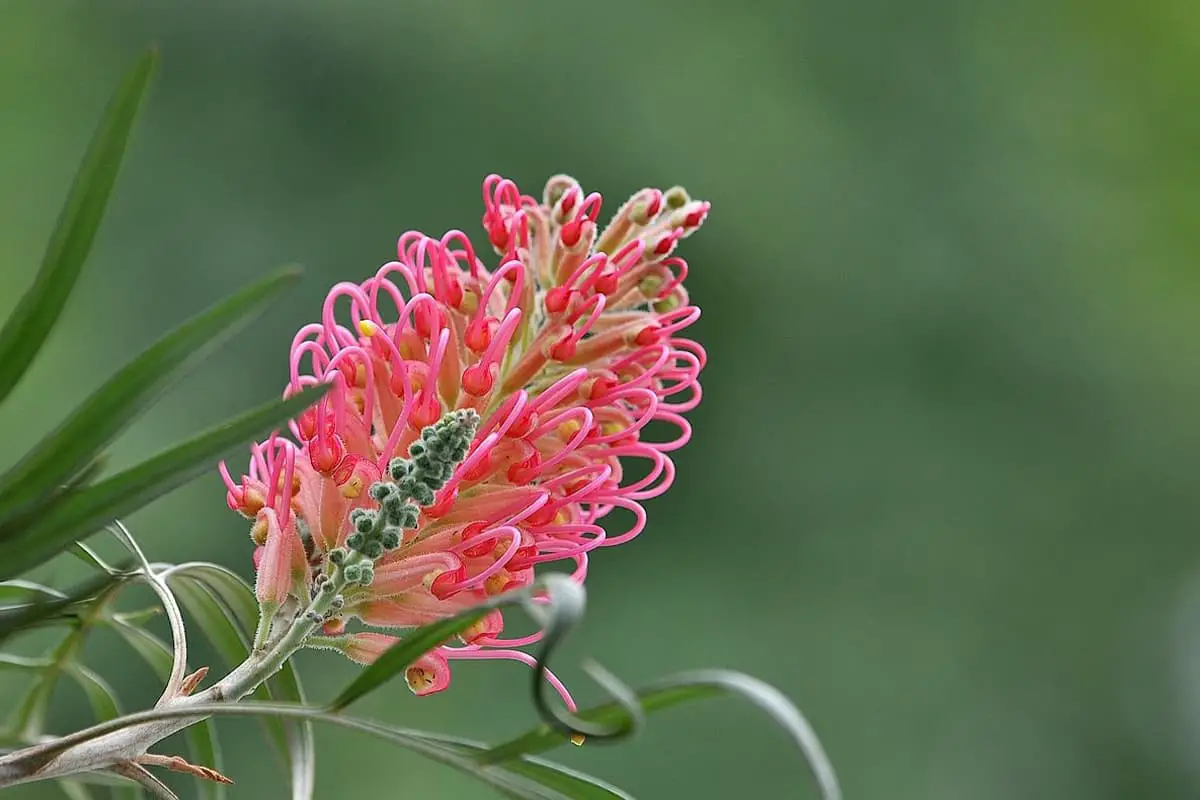
Grevillea banksii, commonly known as Red Silky Oak or Banks’ Grevillea, is a striking evergreen tree belonging to the diverse Proteaceae family. This species typically grows to a height of 4-8 meters (13-26 feet) with a trunk diameter of 15-18 cm (6-7 inches), forming a graceful, conical canopy atop a straight trunk.
The bark of G. banksii is distinctively dark brown, adorned with irregular, shallow vertical fissures. Young branches, buds, and petioles are densely covered with rust-brown or gray-brown pubescence, giving them a velvety texture.
The foliage of this species is particularly noteworthy. Leaves are arranged alternately and are pinnately compound, typically 10-20 cm (4-8 inches) long. The undersides of the leaves are covered in a combination of brown velvet and silvery-grey silky hairs, creating an attractive contrast with the darker upper surfaces.
One of the most striking features of G. banksii is its vibrant inflorescences. The flowers are bisexual and arranged in terminal or axillary panicles, typically 10-15 cm (4-6 inches) long. These brush-like flower clusters are usually a brilliant red, though pink and white cultivars also exist. Each individual flower is rich in nectar, making the tree highly attractive to nectar-feeding birds and insects.
Native to coastal and sub-coastal areas of Queensland, Australia, G. banksii is well-adapted to warm, humid climates and prefers well-drained, acidic soils with a pH range of 5.5-6.5. This species demonstrates remarkable resilience, tolerating hot, sunny conditions, periods of drought, and poor soil quality. While it grows optimally in temperatures above 5°C (41°F), it can withstand brief periods of light frost.
The adaptability and long blooming period of G. banksii make it a popular choice for various landscaping applications. It excels as a background tree in gardens due to its height and attractive form. When incorporated into mixed plantings or dividers, it can form stunning multi-layered plant communities. Its tolerance for challenging conditions also makes it ideal for ecological landscape projects along roadsides and riverbanks.
In addition to its ornamental value, G. banksii has been utilized in pine forest modifications, where it can contribute to understory diversity and provide valuable resources for wildlife. Its nectar-rich flowers support local ecosystems by attracting pollinators and nectarivorous fauna.
When cultivating G. banksii, it’s important to provide adequate drainage and avoid overwatering, as the species is susceptible to root rot in waterlogged conditions. Regular pruning after flowering can help maintain its shape and promote denser growth. While generally pest-resistant, monitoring for scale insects and leaf-miners is advisable in some regions.
In conclusion, Grevillea banksii is a versatile and attractive tree species that offers both aesthetic appeal and ecological benefits. Its striking flowers, interesting foliage, and adaptability to various conditions make it a valuable addition to many landscape designs, particularly in warm climate regions.
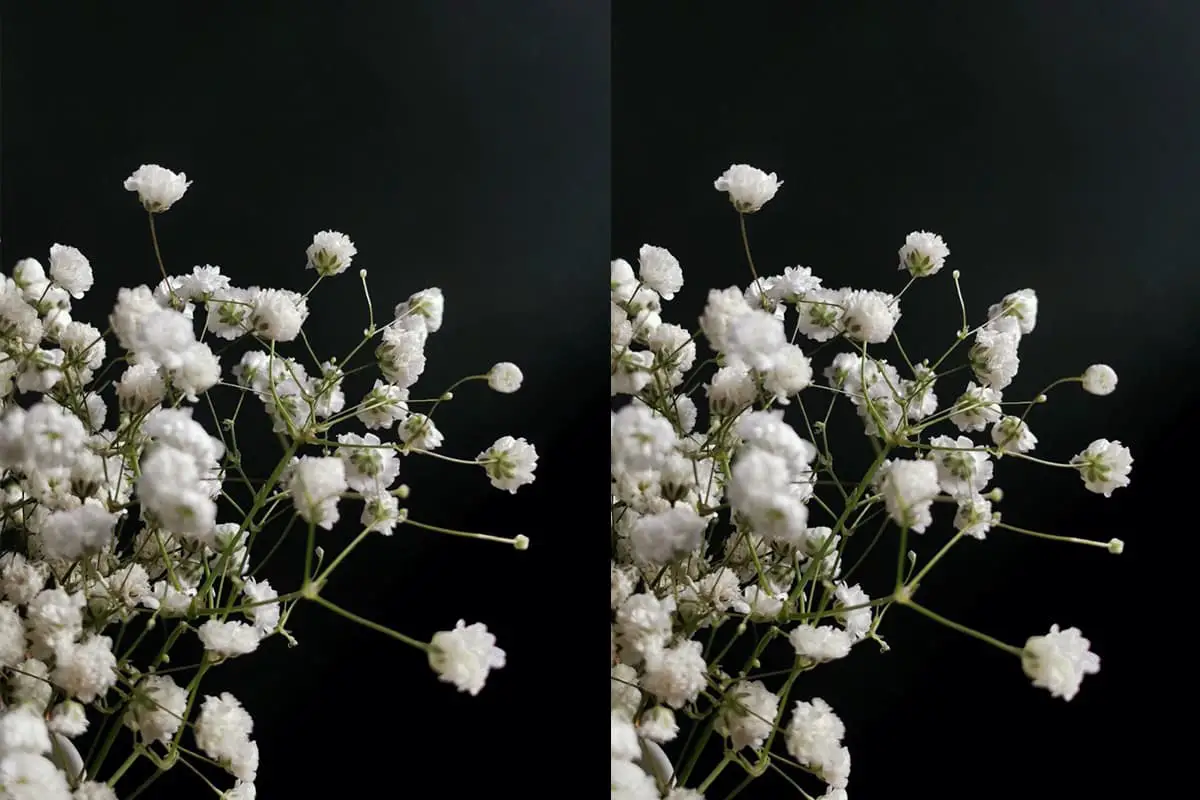
Gypsophila paniculata, commonly known as Baby’s Breath, is a graceful perennial herb belonging to the Caryophyllaceae family. This ornamental plant, prized for its delicate, cloud-like appearance, typically grows to a height of 60-120 cm (24-47 inches), supported by a robust taproot system that can extend up to 4 meters deep, ensuring drought resistance and longevity.
The plant’s architecture is characterized by a highly branched structure, with stems that are glabrous (smooth) or glandular-pubescent near the base. These stems divide into numerous slender branches, creating a bushy, rounded form. The leaves are linear to lance-shaped, glaucous (blue-green), and arranged oppositely on the stems, becoming smaller towards the top of the plant.
Flowering occurs from early summer to early fall, typically June through August, with fruit development following from August to September. The inflorescence is a large, open panicle, bearing numerous tiny (2-3 mm diameter) white or pale pink flowers. Each flower has five petals and ten stamens, creating the misty effect for which Baby’s Breath is renowned.
Native to the Eurasian steppes, Gypsophila paniculata’s natural range includes the Altai mountain region in Xinjiang, China, and extends westward through Kazakhstan, southern Russia (Siberia), western Mongolia, and into parts of central and eastern Europe. In these regions, it thrives in diverse habitats, including riverbeds, grasslands, stabilized sand dunes, rocky slopes, and even disturbed areas like farmland edges. The plant shows a preference for well-drained, alkaline soils and can tolerate altitudes ranging from sea level up to 1,500 meters (4,900 feet).
Due to its adaptability and aesthetic appeal, Gypsophila paniculata has been widely cultivated and naturalized beyond its native range. It has become established in North America, where it is sometimes considered invasive due to its prolific seed production and deep root system. The plant’s global distribution now includes parts of western, central, and eastern Europe, as well as scattered populations across North America.
In horticulture, Baby’s Breath is highly valued for its use in floral arrangements, both fresh and dried. It serves as an excellent filler plant in gardens, providing a soft, ethereal backdrop for more boldly colored flowers. Cultivars have been developed to offer variations in flower size, color intensity, and growth habit, enhancing its versatility in landscape design.
The type specimen of Gypsophila paniculata, which serves as the definitive example of the species, was collected from western Siberia, Russia. This reflects the plant’s origins in the Eurasian steppe ecosystems, where it evolved to withstand harsh continental climates characterized by hot summers and cold winters.
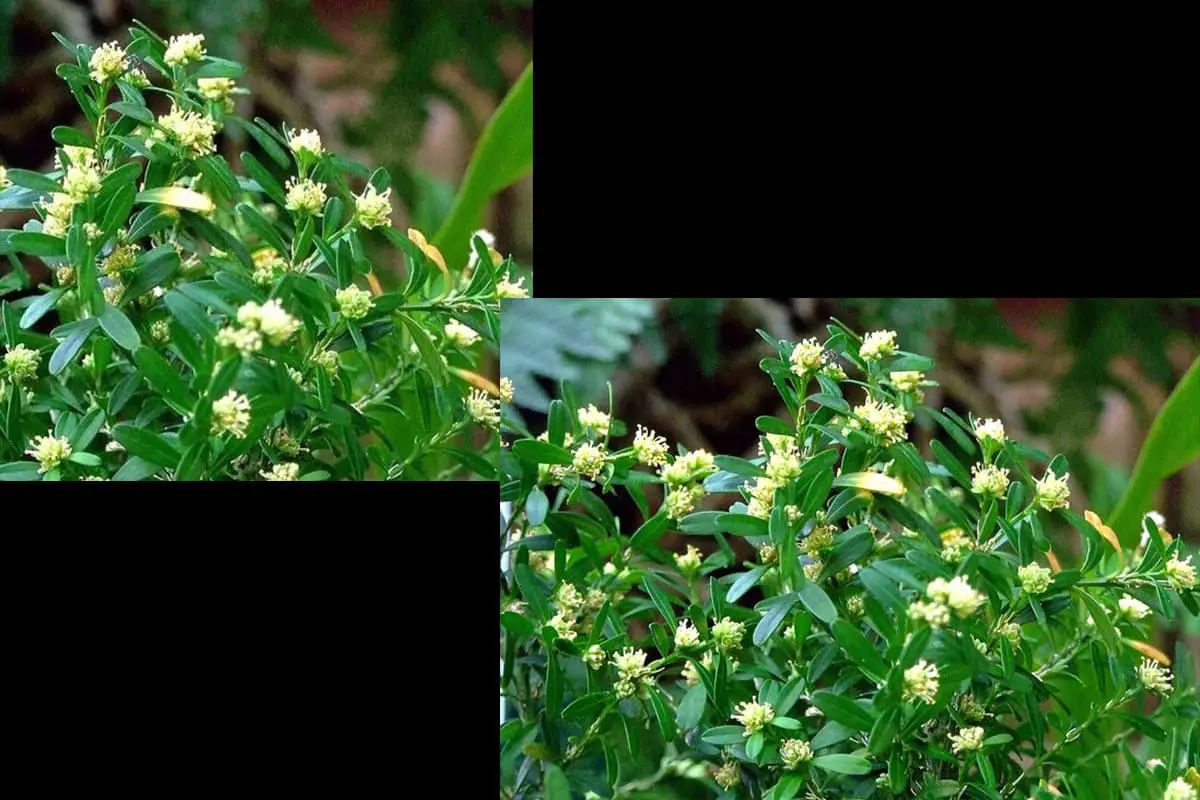
Gardenia Angkorensis Pitard is a rare and endangered species belonging to the Gardenia genus within the Rubiaceae family. This exquisite shrub is native to specific regions in Southeast Asia, including the Hainan province of China and Cambodia.
Distribution and Habitat:
In China, Gardenia Angkorensis is primarily found in Ya County and the eastern regions of Hainan province. Its natural habitat consists of forests and shrublands along mountain slopes and valleys, with a particular affinity for areas near streams. The species’ preference for these specific ecological niches contributes to its rarity in the wild.
Morphological Characteristics:
Phenology:
The fruiting period for Gardenia Angkorensis occurs from August to November, which is crucial information for both conservation efforts and potential cultivation.
Conservation Status:
Gardenia Angkorensis Pitard is currently listed as Endangered (EN) on the IUCN Red List. This classification indicates that the species faces a very high risk of extinction in the wild, primarily due to habitat loss, fragmentation, and potentially limited distribution.
Ecological Significance:
As a member of the Rubiaceae family, which includes economically important plants like coffee and quinine, Gardenia Angkorensis may hold untapped potential for horticultural, medicinal, or ecological applications. Its preservation is vital not only for maintaining biodiversity but also for future scientific research and possible sustainable use.
Conservation Efforts:
Given its endangered status, conservation initiatives for Gardenia Angkorensis are crucial. These may include habitat protection, ex-situ conservation in botanical gardens, and further research into its ecology and propagation techniques to support population recovery efforts.
This species represents an important component of the unique flora in its native range, highlighting the need for continued study and conservation measures to ensure its survival for future generations.
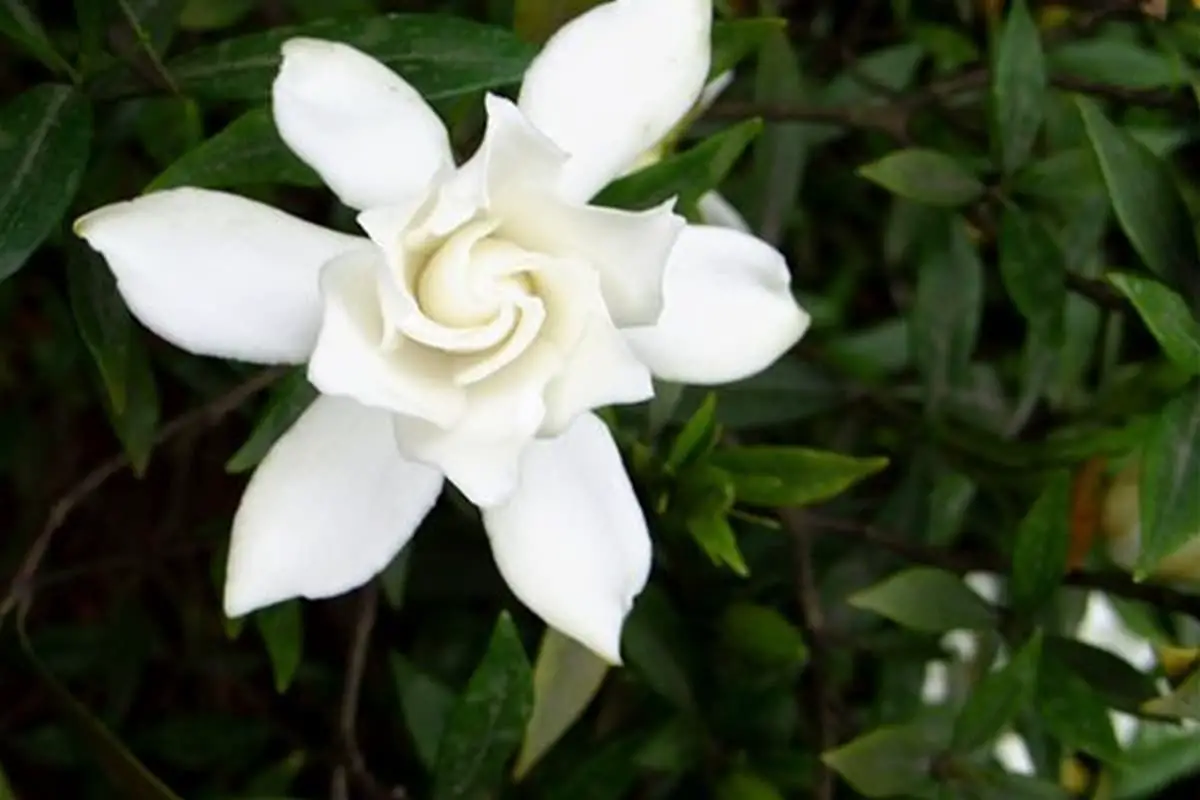
Gardenia jasminoides ‘Ellis Fortuniana’ (commonly known as Four Seasons Gardenia): Gardenia jasminoides ‘Ellis Fortuniana’ is a cultivar of Gardenia jasminoides, belonging to the Rubiaceae family. This cultivar is renowned for its ability to bloom throughout the year, earning it the moniker “Four Seasons Gardenia.”
This cultivar exhibits a compact, dwarf shrub habit, with branches often growing at oblique angles. Its foliage is notably smaller and narrower compared to the species Gardenia jasminoides. The leaves are glossy, dark green, and lanceolate to ovate in shape, tapering towards the base.
Under optimal conditions, ‘Ellis Fortuniana’ can produce flowers continuously throughout the year. The blossoms are double-petaled, pure white, and exude an intense, sweet fragrance characteristic of gardenias. The pristine, waxy flowers create a striking contrast against the deep green foliage, making this cultivar particularly ornamental.
‘Ellis Fortuniana’ is shade-tolerant but performs best in partial shade to filtered sunlight. It thrives in warm, humid climates and should be protected from harsh, direct sunlight, especially during the hottest parts of the day. This cultivar requires well-draining, acidic soil (pH 5.0-6.5) that is rich in organic matter and consistently moist but not waterlogged.
Regular fertilization is crucial for maintaining healthy growth and abundant blooming. Slow-release, acid-forming fertilizers formulated for acid-loving plants are ideal. Organic options such as well-composted manure or acid peat moss can also be beneficial when incorporated into the soil.
Proper care includes maintaining high humidity levels, which can be achieved through regular misting or placing the plant on a pebble tray filled with water. Pruning should be done after flowering to maintain shape and encourage bushiness.
Gardenia jasminoides ‘Ellis Fortuniana’ is highly valued as a container plant for indoor and outdoor spaces, adding both visual appeal and fragrance. Its compact size makes it suitable for smaller gardens, patios, and even as a bonsai specimen. In landscaping, it excels in mixed borders, as a low hedge, or as a focal point in sensory gardens.
This cultivar may be susceptible to common gardenia issues such as bud drop, chlorosis (yellowing leaves due to iron deficiency in alkaline soils), and pests like mealybugs and spider mites. Regular monitoring and maintaining optimal growing conditions are key to preventing these problems.